

to
March / April 2020 Volume 48 Issue 2 www.njjs.or g Magazine of the New Jersey Jazz Society
Dedicated
the performance, promotion and preservation of jazz.
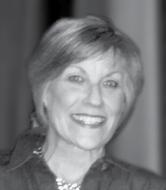
March is Women’s History Month and April is Jazz Appreciation Month (JAM). Please join me in acknowledging and celebrating the vital role of women throughout history, and more specifically recognizing the great contributions women have made and ARE making to the art of jazz.
Last year I recommended the following materials for all who wish to learn more about women’s historic place in the jazz lexicon: 1.) The article focused on the '20s, '30s & '40s titled “The Best of the All-Women Swing Bands” by William Ewanick on the website www.medium.com. 2.) the 2011 documentary The Girls in the Band directed by Judy Chaikin which presents the untold stories of female jazz and big band instrumentalists and their journeys from the late 1930’s to the present day. 3.) Sherrie Tucker’s book Swing Shift chronicling the forgotten history of the all-girl big bands of the World War II era.
The culture and conditions that have historically existed for women within the genre of jazz are well documented but the August 2019 Vanity Fair article “Sisters of Swing” (Google it – it’s a must read!) sheds new light on the role of women within this art form. With this focus, I want to take women out of the history books and highlight the extraordinary influence women are having on today’s jazz scene. Music critic David Hajdu notes, “Some fearless women
Celebrate Her-story. Celebrate jazz. Celebrate Her-story in jazz!! ALL
plowed through with machetes so that another generation can say, ‘This is possible. Maybe there’s a place for me.’ Women as performers, composers, and innovators is the story in jazz today.”
This issue of Jersey Jazz highlights a host of established and immerging female jazz artists and influencers: Bria Skonberg, Ann Hampton Callaway, Tierney Sutton, Catherine Russell, Heather Thorn, Mariel Bildsten, Sarah Hanrahan, Nicki Parrott, Jacquie Lee, Lucia Jackson, Rebecca Kilgore, Carolyn Lee Jones, Sinne Eeg, Amber Weekes, Gail Boyd, and Martha Glaser. Know their names and know how they have influenced and will continue to enrich the art of jazz. Guitarist Mary Havorson speaks the truth when she says, “The more women out there doing it, the more it encourages young women to start.”
Somewhere near you, there’s a fabulous jazz event scheduled. Actively take part in the preservation and promotion of jazz and take a young person with you to an event and introduce them, perhaps for the first time, to America’s great art form – jazz.
To that end, JAM heralds and celebrates the extraordinary heritage and history of jazz. Originally intended as a catalyst to encourage people of all ages to actively participate in jazz, I encourage you to thoroughly read this magazine and attend as many performance offerings as possible.

Clarification: An article in the January-February issue of Jersey Jazz (‘NJ SUNDAY JAZZ SOCIALS’, Page 6) described alto saxophonist Alex Laurenzi as,”a protege of Bruce Williams.” Laurenzi considers Williams “my alto godfather”, but he has never taken lessons from Williams.

2 March / April 2020
THAT’S JAZZ! By Cydney Halpin President, NJJS COLUMNS All That’s Jazz! ............................... 2 Editor’s Choice 4 Jazz Trivia ..................................... 31 Dan’s Den ..................................... 42 Not Without You! ....................... 49 From the Crow’s Nest ................. 51 ARTICLES/REVIEWS Bria Skonberg: No Limits. ............ 5 NJJS Sunday Jazz Socials. 6 Big Band in the Sky 8 Rising Star: Evan Sherman.......... 12 Jazz at the Bickford. ..................... 14 Jazz in Metuchen ......................... 16 NJJS Grant from SAPF ................ 16 NC Jazz Festival 18 Chicken Fat Ball. .......................... 20 Jazz at McCarter .......................... 22 WBGO Overnight Host 22 Jazz on a Sunday Afternooon ..... 23 Jazz at NJPAC: In Technicolor .. 26 Montclair’s Lee Family 28 Jazz Nights in Princeton ............ 30 WPU Spring Jazz Room ............. 32 Jazz at 1867 Sanctuary 34 Danny Tobias with Strings ........ 34 New ATMA President ................ 36 Book Reviews 44 Caught in the Act ....................... 50 Jazz at Rutherfurd Hall .............. 51 THANK YOU TO OUR ADVERTISERS: 1867 Sanctuary, Amani, Arbors Records, Bell & Shivas, Mark Clemente - Chord Melodies, HACPAC, Jim Eigo – Jazz Promo Services, James
Arts Council, McCarter
New Jersey City University,
University
THIS ISSUE
Pansulla, Jazzdagen Tours, JazzFest at Sea, Leonieke Scheuble, Metuchen
Theatre,
NJPAC, Ocean County College, Rutherfurd Hall, Sandy Sasso, Shanghai Jazz, SOPAC, Swingadelic, WBGO, William Paterson
IN
R.I.P. Jimmy Heath Page 8 On Cover: Bria Skonberg photo by by Davio Acosta
Photo by Mitchell Seidel
On December 15, 2019, executive officers were elected within the NJJS board of directors. It’s my privilege to announce that Dave Dilzell has been elected to the office of Treasurer and Mitchell Seidel has been elected as the VP of Music Programming. This will be the first time that Dave is holding an executive position while Mitchell is returning to a position he previously served for many, many years. I’m grateful that both gentlemen are willing to hold executive posts and am confident that each will do a stellar job in his position. Join me in thanking Carrie Jackson for serving the past two years as VP of Music Programming, working closely with the revitalized Music Committee to bring exceptional talent to our Sunday Socials. Please join me in thanking all three of these individuals for their dedication and willingness to serve.
This new decade marks the first time in almost a decade and a half that Mike Katz will not be serving NJJS in an executive board position, however he will continue to serve on the board of directors. Please join me and my fellow board members in thanking Mike for his unprecedented number of years in an executive board position – having served as Vice President, President and Treasurer twice! - and for his longstanding dedication and service to the Society.
After many years, the New Jersey Jazz Society has a CHANGE OF ADDRESS. The new address is: New Jersey Jazz Society, P.O. Box 223, Garwood, NJ 07027. The new phone number is 908-380-2847. We can also be reached via email at Info@njjs.org.
In an ongoing attempt to more efficiently manage the administrative aspects of NJJS membership and reduce USPS mailings, we’ve printed your membership expiration date by your mailing address on the back of your magazine. Turn it over and take a look! If you’ve reached your expiration date, please renew your membership online, via Paypal or credit card, at www.njjs.org on the “Join & Support/Membership” page. You can also always renew by check. Please note “Membership” on the memo line and mail to New Jersey Jazz Society, P.O. Box 223, Garwood, NJ 07027. Your membership is vital to the operations of NJJS and we thank you for your continued patronage.
The New York Hot Jazz Camp returns for its fifth year to the historic Greenwich House Musical School April 13 – 19th. Founded and Co-Directed by Molly Ryan and Bria Skonberg, NYHJC is an immersive experience with notable faculty comprised of New York’s finest trad jazz musicians and recording artists, guest lecturers, master classes, jams and nights on the town, that culminates with camper and faculty showcases. For more details please see page 10 or visit www.nyhotjazzcamp.com about participation and concerts.
NJJS must look to multiple revenue streams to support our mission. So as a reminder, “Turn your Amazon purchases into a force for good.” NJJS has joined the AmazonSmile Gives program where 0.5% of the price of your eligible smile.amazon.com purchases will go directly to us! It’s the same Amazon you know but a separate website. Same products, same service - but to generate donations you must ALWAYS SHOP AT smile.amazon.com.

Many advertising and sponsorship opportunities exist within NJJS. If you’re interested in advertising in Jersey Jazz, or on our website, or both, would like to sponsor a Generations of Jazz presentation or Social, make an In Memoriam donation, contribute to our scholarship fund, or become a corporate sponsor with tiered benefits, please contact me at pres@njjs.org. NJJS is a qualified I.R.C. 501(c)(3). Donations are always welcome

Cydney Halpin President email: pres@njjs.org
Jay Dougherty Executive VP email: vicepresident@njjs.org
Dave Dilzell Treasurer email: treasurer@njjs.org
Pete Grice VP, Membership email: membership@njjs.org
Sanford Josephson VP, Publicity email: sanford.josephson@gmail.com
Mitchell Seidel VP, Music Programming music@njjs.org
Irene Miller Recording Secretary
Jack Stine Co-Founder
Mike Katz Immediate Past President
DIRECTORS
Ted Clark, Cynthia Feketie, Stephen Fuller, Mike Katz , Peter Lin, Caryl Anne McBride, Robert McGee, James Pansulla, Stew Schiffer, Marcia Steinberg, Elliott Tyson, Jackie Wetcher ADVISORS
Don Braden, Al Kuehn, Bob Porter, Holli Ross
www.njjs.org
Printed by: Bernardsville Print Center

March / April 2020 3
Magazine of the New Jersey Jazz Society Volume 48 • Issue 2 USPS® PE6668 Jersey Jazz (ISSN 07405928) is published bi-monthly for members of The New Jersey Jazz Society P.O. Box 223 Garwood, NJ 07027 908-380-2847 info@njjs.org Membership fee is $45/year. Periodical postage paid at West Caldwell, NJ. Postmaster please send address changes to P.O. Box 223 Garwood, NJ 07027 All material in Jersey Jazz, except where another copyright holder is explicitly acknowledged, is copyright ©New Jersey Jazz Society 2020 All rights reserved. Use of this material is strictly prohibited without the written consent of the NJJS. Sanford Josephson Editor email: editor@njjs.org Steve Kirchuk Art Director email: art@njjs.org Fradley Garner International Editor email: fradleygarner@gmail.com Mitchell Seidel Contributing Photo Editor email: photo@njjs.org Contributing Editors Dan
Bill Crow, Schaen Fox, Sandy Ingham, Joe Lang
Morgenstern,
Contributing Photographers
NEW JERSEY JAZZ SOCIETY OFFICERS 2020
Dave Dilzell, Christopher Drukker Tony Graves
Virtually Unknown to the Public, Laurie Frink Was a Guru to Peers
By Sanford Josephson - Jersey Jazz Editor
Since March is Women’s History Month, I thought it would be appropriate to recall a female jazz pioneer from the 1970s and early ‘80s -trumpeter Laurie Frink. I saw Frink perform several times as lead trumpeter with Gerry Mulligan’s “new” Concert Jazz Band, which won a Grammy Award in 1982 for its only recording, the DRG album, Walk on the Water

In addition to Mulligan’s band, Frink also played in bands in the ‘70s led by Benny Goodman and Mel Lewis. Unlike today, when women instrumentalists have exploded onto the jazz scene, the sight of a female in the brass section then was very rare. Later in her career, Frink also performed with bands led by Maria Schneider, John Hollenbeck, and Ryan Truesdell. As impressive as her playing was -and it was -- she will probably be remembered most for her teaching ability.
One trumpeter she helped was Dave Douglas, who contacted Frink in the early ‘90s because he was having embouchure difficulties. She helped him, and he later recounted that it “was like a combination of therapy, gym instruction, and music lesson.” In a Twitter post shortly after Frink died in July 2013, trumpeter Nadje Noordhuis said, “Laurie Frink changed my life.” Others who took lessons from her have included Bria Skonberg, Ambrose Akinmusire, Mike Davis, and Ingrid Jensen. Upon hearing of Frink’s death, Skonberg, on Facebook, recalled that, “Even before I moved to New York, everyone, and I mean EVERYONE in the trumpet/brass community said, ‘Oh, you study trumpet? You should take a lesson with Laurie Frink.’ What an amazing woman and inspiration.”
I never met or interviewed Frink, although I tried about 11 years ago when I was updating an article on Mulligan I had written in 1981. She informed me that she was no longer doing interviews. So, I only know her through her talent as a trumpeter. In the jazz community, we often speak of musicians deserving of wider recognition. And, there are plenty. Frink is virtually unknown among the public, even the jazz public. But, she did reach widespread recognition and esteem among her musical peers.
When drummer/composer Hollenbeck released his 2018 Amsterdam Records album, All Can Work, he dedicated it to Frink. Reviewing the album in DownBeat, Frank Alkyer wrote that, “It’s a fitting tribute to an artist who was a beloved member of this ensemble, a revered educator, and a highly respected musician on the New York jazz scene . . . It’s wonderfully complex music played beautifully, with precision and abandon, by a band that has spent a good deal of time together. Somewhere, Laurie Frink is smiling.”
Nate Chinen wrote a tribute to Frink in JazzTimes, saying,“She fell somewhere between a sideline coach and a mountaintop guru, with maybe a wry touch of the stand-up comic. It’s for her contribution as a mentor and instructor that Frink will probably be best remembered, but there’s no category for that in the critics’ polls.” That’s too bad.
About NJJS
Founded in 1972, The New Jersey Jazz Society has diligently maintained its mission to promote and preserve America’s great art form – jazz.
To accomplish our mission, we produce a bi-monthly magazine, Jersey Jazz; sponsor live jazz events; and provide scholarships to New Jersey college students studying jazz. Through our outreach program Generations of Jazz, we provide interactive programs focused on the history of jazz
The Society is run by a board of directors who meet monthly to conduct Society business. NJJS membership is comprised of jazz devotees from all parts of the state, the country and the world.
Visit www.njjs.org or email info@njjs.org for more information on our programs and services.
MEMBER BENEFITS
10 FREE Concerts Annually at our “Sunday Socials”
Bi-Monthly Award Winning Jersey Jazz Magazine - Featuring Articles, Interviews, Reviews, Events and More.
Discounts at NJJS Sponsored Concerts & Events.
Discounts at Participating Venues and Restaurants
Support for Our Scholarship and Generations of Jazz Programs
Musician Members
FREE Listing on NJJS.org “Musicians List” with Individual Website Link
FREE Gig Advertising in our Bi-monthly eBlast
The Record Bin
A collection of CDs & LPs available at reduced prices at most NJJS concerts and events and through mail order www.njjs.org/ Store
JOIN NJJS
Family/Individual $45 (Family includes to 2 Adults and 2 children under 18 years of age)
Family/Individual 3-Year $115
Musician Member $45 / 3-Year $90 (one time only, renewal at standard basic membership level.)
Youth $15 - For people under 21 years of age. Date of Birth Required.
Give-A-Gift $25 - Members in good standing may purchase unlimited gift memberships. Applies to New Memberships only.
Fan $100
Jazzer $250
Sideman $500
Bandleader $750
Corporate Membership $1000
Members at Jazzer level and above and Corporate Membership receive special benefits. Please contact Membership@njjs.org for details.
The New Jersey Jazz Society is qualified as a tax exempt cultural organization under section 501(c)(3) of the Internal Revenue Code, Federal ID 23-7229339. Your contribution is tax-deductible to the full extent allowed by law.
For more Information or to join, visit www.njjs.org

4 March / April 2020 THE EDITOR’S CHOICE
Bria Skonberg: ‘New Album Material, Some Tunes Anchored in Tradition, and Whatever Inspires Me That Week’
By Sanford Josephson
Trumpeter/vocalist Bria Skonberg made her first trip to New York (from British Columbia) in 2006 for an International Association for Jazz Education (IAJE) conference. “One of the most impactful moments,” she recalled, “was a final concert where the Jon Faddis Orchestra was on stage facing the Count Basie Orchestra, trading tunes. I couldn’t believe my ears. Eventually, there was a celebration of NEA Jazz Masters, and out came Slide Hampton, Nancy Wilson, Freddie Hubbard, Tony Bennett, Bob Brookmeyer and more; and my head just exploded.”
One of Skonberg’s friends on that trip was Seattle-based trombonist Emily Asher. “Emily and I both decided on that trip to move to New York City, which she did in 2008; and I followed two years later.” Prior to the move, Skonberg had befriended trombonist Jim Fryer, whom she met on the West Coast. And, through that connection, she began visiting the New York-New Jersey area,
playing and singing with him at some local venues. Her first area performance, with Fryer, was in 2008 at the Morris Museum’s Bickford Theatre in Morristown, a venue that “holds a very special place in my heart because of the warm reception.”
On Saturday, April 18, Skonberg will be bringing her current quartet to the Hackensack Performing Arts Center, and on May 9, she will be appearing at the Kimmel Center in Philadelphia. In those early days at the Bickford, she and Fryer performed mostly traditional tunes -- jazz associated with Louis Armstrong, Bix Beiderbecke and Jelly Roll Morton and American Songbook standards by composers such as George Gershwin and Irving Berlin. Skonberg has not abandoned that music, but, adding songwriting to her skill set, she has branched out into some more adventurous musical directions, exemplified by her latest, self-produced album, Nothing Never Happens, released in November 2019.


At HACPAC and Kimmel, her musical selections will be, she said, “mostly new album material, some tunes anchored in tradition, and
“Stephane [Wrembel] is an amazing musical force! I love his playing and his energy with both his band mates and the audience.”
whatever inspires me that week. I’m definitely looking forward to these shows. It will be my regular working quartet of Darrian Douglas (drums), Devin Starks (bass), and Chris Pattishall (piano), which is my favorite combination. So much of our sound comes from nuance, dynamics, and thoughtful details, so it’s important that we’re no longer reading the music, and just listening to each other.”
While Nothing Never Happens might disappoint some of Skonberg’s traditionalonly enthusiasts, AllAboutJazz’s Jerome Wilson called the album “the product of a more mature and polished musician . . . Skonberg’s singing and playing carries a level of grit and emotion she has never shown before.”
With Pattishall, Starks, Douglas, and guitarist Yasushi Nakamura, Skonberg recently performed two songs from Nothing Never Happens -- “So Is The Day” and
continued on page 10
March / April 2020 5 NO LIMITS
Xylophonist Heather Thorn and Trumpeter
Mark Morganelli Lead Trios in March and April
Story and Photos by Mitchell Seidel
A Heather Thorn performance can be called a trip into the Roaring ‘20s. The question is whether it’s back to the 1920s or forward to the 2020s. The Orlando, Florida, resident’s instrument of choice is the xylophone, something of a throwback to the early days of jazz, before the invention of the amplified vibraphone, popularized during the Swing Era by the likes of Lionel Hampton and Red Norvo.

While Thorn’s instrumentation is anchored in the past, her -- and her band’s -- repertoire spans several generations. What can you say from a set that might include a Benny Goodmanesque “Sing, Sing, Sing,” a breakneck rendition of “Tico Tico,” a transcribed Red Norvo solo of “I Got Rhythm”, and a nod to Ray Charles’ version of “I Can’t Stop Loving You”? With the vintage instrumentation of the xylophone and her modern musical aesthetic, Thorn brings to mind some of the newer New Orleans brass bands in that she’s unafraid to perform a broad range of music. As a player she is capable of performing sweetly melodic solos for some tunes, then sifting to furiously mallet-bending runs for others.
The percussionist can often be heard leading her band, Vivacity, a nine-piece retro swing group with a large following in central Florida, as well as orchestral groups featured in the Disney Orlandoarea parks. The Canadian-born musician’s fame reaches beyond her home. Last year Vivacity, featuring Thorn, was the headline act for the I Love Jazz International Jazz Festival in Brazil. Last November, she was one of the stars at the Suncoast Jazz Classic in Clearwater Beach, FL.
On Sunday, March 15, Thorn will be leading a trio at the New Jersey Jazz Society’s Jazz Social at Shanghai Jazz in Madison. Following this performance, she is booked as a guest performer one evening with Vince Giordano’s Nighthawks in Manhattan. Thorn has invited along two metro area stalwarts of the swing tradition, saxophonist Michael Hashim and pianist Alberto Pibiri to join her at the Social.
Despite his youthful appearance, Hashim has been a fixture on the jazz scene for more than 40 years, going back as far as the Widespread Depression Jazz Orchestra in the 1970s. A talented leader and frequent sideman, he has performed with such musicians as guitarist Chris Flory, bassist Dennis Irwin, drummer Kenny

6 March / April 2020
SUNDAY JAZZ SOCIALS
NJJS
Washington, keyboardist Mike LeDonne, trumpeter Roy Eldridge, drummer Jo Jones, pianist Brooks Kerr, drummer Sonny Greer, and pianists Jimmy Rowles and Judy Carmichael. Hashim is no stranger to the New Jersey Jazz Society, having performed at the annual Pee Wee Russell Memorial Stomp, a Jazz Social in a small group and in concert with his Billy Strayhorn Orchestra.
Italian-born Madison resident Pibiri is heavily influenced by the work of Oscar Peterson and also has earned a spot as one of the better go-to names in swing jazz. He is a mainstay of saxophonist Adrian Cunningham’s band, Professor Cunningham’s Old School, and appears on its latest Arbors CD release, Professor Cunningham and His Old School Swings Disney.
Trumpeter/flugelhornist Mark Morganelli can best be described as a New York bebopper with the soul of a Brazilian. In fact, his latest CD, Brasil! (Jazz Forum Records: 2019) finds him enveloped in a rich collection of authentic Brazilian musicians and music. Fans of Ivan Lins, Luis Bonfa, and particularly Antonio Carlos Jobim, will find a lot to appreciate in Morganelli’s interpretations of their music.
Recognized as much a jazz producer as he is a performer, Morganelli played with, presented and recorded with such jazz artists as Kenny Barron, Barry Harris, Red Rodney, Claudio Roditi, Donald Harrison and Art Blakey. Starting with his Greenwich Village loft, The Jazz Forum, shortly after graduating from Bucknell University in the late 1970s, Morganelli prided himself on presenting renowned musicians in a casual setting. An unusual feature of the Jazz Forum was that it differed from the local “loft” scene in that it featured mainstream rather than avant-garde music. It was a “hang” where musicians came to play and listen.
Over the years Morganelli’s production credits grew to include booking the uptown incarnation of the new Birdland, a Carnegie Hall tribute to Dizzy Gillespie, the Riverside Park Arts Festival, concerts at the Tarrytown Music Hall, outdoor music series in parks throughout Westchester County and his latest setting for The Jazz Forum, a 90-seat Tarrytown jazz club that is home base for his non-profit Jazz Forum Arts.
Accompanying Morganelli at the Sunday, April 19, NJJS Jazz Social will be two of the musicians who were part of the edition of the Jazz Forum AllStars that contributed to his latest album, “Brasil!,” accordionist/vocalist Eddie Monteiro and guitarist/ vocalist Nanny Assis.
Longtime New Jersey resident Monteiro is recognized as one of the great accordionists in jazz as well as being a talented vocalist. With a Midi-accordion, an instrument that can produce multiple chords and notes, he is capable of playing a broad range of music that goes well beyond what one would expect from a non-electrified accordion. His sound is best likened to entire band, rather than a single instrument, plus, the midi is able to duplicate the notes of his singing voice to further expand his range.
Bahia, Brazil-born Assis brings a strong amount of authenticity to the group. Internationally known as a guitarist, singer, percussionist and composer, he draws inspiration from the music of his native country as well as American jazz.
The New Jersey Jazz Society produces 10 Sunday Jazz Socials a year, all of which are free to members. Admission is $10 for nonmembers, and there is a $10 food/beverage mininum for all attendees. Shanghai Jazz is located at 24 Main St. in Madison. Doors open at 2:30 p.m., and the music is performed from 3-5 p.m., with one short intermission. For more information, email music@ njjs.org.
Funding for the NJJS Socials has been made possible in part by Morris Arts through the New Jersey State Council of the Arts/ Department of State, a partner agency of the National Endowment of the Arts.


March / April 2020 7
R.I.P.: Jimmy Heath, Claudio Roditi, Vic Juris
By Sanford Josephson
Jimmy Heath: From ‘Little Bird’ To Giant of the Tenor Saxophone
Tenor saxophonist Jimmy Heath often talked about all the jazz giants he worked with -- Dizzy Gillespie, John Coltrane, Miles Davis, to name a few. But, in 2003, Heath was named a Jazz Master by the National Endowment for the Arts, propelling him into that same legendary stratosphere.
Interviewed by the NEA after he won the award, Heath recalled the moment he realized he wanted to become a jazz musician. “When I was about 15 or 16,” he said, “I went to hear the Glenn Miller band. When they put the blue lights on the saxophone section and they played, ‘Serenade in Blue’, I was in heaven. And I said, ‘That’s what I want to do, and that’s where I want to be, on the stage playing beautiful music’.”
Heath was born on October 25, 1926, in Philadelphia and died at the age of 93 this past January 19 at his home in Loganville, GA. He was the middle brother in a trio of outstanding jazz musicians. His older brother, bassist Percy Heath, Jr., died in 2005. His younger brother is the hard bop drummer, Albert ‘Tootie’ Heath.
In the late 1940s, Heath led a jazz band in Philadelphia that included Coltrane and Benny Golson. At 22, he moved to New York City, joining Percy in Gillespie’s big band. He also played in Gillespie’s sextet, and both brothers performed with bebop trumpeter Howard McGhee.
Heath reminisced about those years in a 1991 interview with Newsday. “Man,” he said, “you cannot imagine what those years were like unless you were actually there. Ideas were bouncing off everywhere at every jam session. You couldn’t wait to hear whatever Bird or Dizzy were doing and how it could inspire you in whatever it was you were doing.”
He acquired the nickname, “Little Bird” because of his small physique and his playing which was influenced by Parker. To separate himself from comparisons to Parker, he changed from alto to tenor sax in 1950, and he was part of Miles Davis’ band in the early ‘50s. Later in the decade he co-led a quintet with trumpeter Kenny Dorham and also began to devote more
time to composing and arranging.
In 1959, when Coltrane left the Miles Davis Quintet, Davis wanted to replace him with Heath. That, however, was after Heath had struggled with a drug problem. He was imprisoned on drug charges in 1955, kicking the habit while he was in prison, but the terms of his probation prevented him from touring. “Prison,” he told the Hartford Courant in 2010, “knocked a hole in my life. But, in retrospect, it was like a blessing because some of my friends who continued to do the stupid thing died young.”
Heath’s first album as leader, The Thumper (Riverside: 1960), featured Nat Adderley on trumpet, Curtis Fuller on trombone, Wynton Kelly on piano, Paul Chambers on bass, and Heath’s brother, Tootie, on drums. Writing the day after Heath’s death, The Guardian’s John Fordham said that album “immediately impressed the jazz world with the warm authority of his composing on such striking tracks as ‘For Minors Only’.” Other notable albums in the ‘60s were The Quota (Decca Riverside: 1961) which featured Freddie Hubbard on trumpet and On the Trail (Riverside: 1964) with Kelly on piano and Kenny Burrell on guitar.
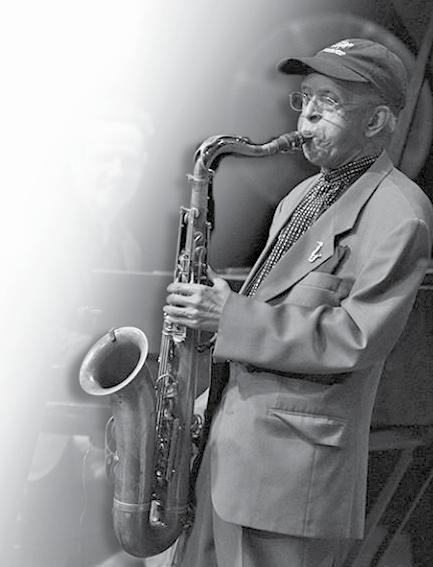
family.” Cowell spent several years as Director of Jazz Studies at Rutgers’ Mason Gross School of the Arts.
In the 1970s, Heath formed the Heath Brothers Quartet with his brothers and pianist Stanley Cowell. It later expanded to a septet with guitarist Tony Purrone and Heath’s son, James Mtume, on percussion. In a Facebook post, Cowell said, “I am saddened by the passing of my mentor and friend, Jimmy Heath. But, I am honored to have known and learned so much from him. Touring with the Heath Brothers was a foundational highlight of my music career. My life is forever indebted to him and his
The Heath Brothers’ first album, Marchin’ On, was released on Strata-East Records in 1976, the same year that Heath premiered a long-form piece called “The Afro-American Suite of Evolution”. The New York Times’ John S. Wilson called it “an illustrative survey for which Mr. Heath showed his versatility by composing segments that caught the spirit of the various periods.” In his autobiography, I Walked With Giants, written with Joseph McLaren (Temple University Press: 2010), Heath, speaking about his quartet and Marchin’ On, said, “It was a time of transition in the jazz world. I was trying to evolve and create music that was acceptable to the generation of the ‘60s and ‘70s. In fact, I’ve been told by certain people that they started listening to jazz as a result of what the Heath Brothers were recording.” After Purrone and Mtume joined the band, the 1980 album, Live at the Public Theater (Columbia) was nominated for a Grammy. Among the tracks on that album, currently only available on vinyl, is a Jimmy Heath original, “Sassy Samba”,

8 March / April 2020
BIG BAND IN THE SKY
Photo by Jeff Dean
dedicated to Sarah Vaughan. Heath received another Grammy nomination in 1993 for his Polygram Records album, Little Man, Big Horn
The group broke up in the mid-1980s when Percy Heath joined the Modern Jazz Quartet. In 1986, Jimmy Heath took over as head of the relatively new jazz program at Queens College. He spent10 years there, helping to start a master’s course of study. He also shared his expertise with students at William Paterson University and at the Stanford Jazz Workshop.
At WPU, he was an Artist in Residence for its Summer Jazz Workshop and a guest soloist with the WP Jazz Orchestra. “With the students,” said Dr. David Demsey, WPU Coordinator of Jazz Studies, “Jimmy was magic! Working with the young and less experienced high school students, he seemed to have a radar that could instantly know their level and give them information and inspiration to help them get to the next level.” With more advanced college students, Demsey told Jersey Jazz, “he found a way to push them, challenge them, while always being upbeat, positive, inspiring, and often hilarious. For them, his stories about his childhood friends, John Coltrane, Benny Golson, etc. and his times with Monk, Dizzy Gillespie, having Charlie Parker as guest soloist with his big band, serve as priceless connectors to the essence of jazz history.”
In a Facebook post, Ernie Rideout, Marketing Director of the Stanford Jazz Workshop, said Heath and his brothers, Tootie and Percy, “were a huge part of the SJW experience for so many students, artists, and faculty members over the past several decades.”
Jeb Patton, the pianist in Heath’s recent bands, simply thanked Heath on Facebook, “for everything you’ve given us. I’ll never forget your smile, the voice of your saxophone, your love of family, your never ending musical quest -- on stage, back stage, at the piano, behind your computer, even on the airplane and -- most of all -your wide open arms, so supportive of musicians from all walks of life.”
In addition to his son, James and brother, Tootie, Heath is survived by his second wife, Mona Brown; their daughter, Roslyn; seven grandchildren and seven greatgrandchildren.


Claudio Roditi: His Warmth and Sense of Humor
Matched His Brilliance on the Trumpet
The last time I saw Claudio Roditi perform was on a Tuesday night during the summer of 2017 at the weekly Sweet Sounds of Jazz festival in Westfield. His performance was brilliant, and his banter with the audience was as delightful as always.
“When I first began to listen to the music,” he told the crowd, “people were telling me about Chet Baker. I was 12 years old, and I went into a record store and asked to look at jazz trumpet records. The album I bought was Dizzy Gillespie and Roy Eldridge with Oscar Peterson. Next came Chet Baker, and third was Miles Davis.” He then played Davis’ “So What” from his celebrated Kind of Blue album. Roditi’s pianist that night was Tomoko Ohno. “I am so sad to hear that Claudio has left us,” she told Jersey Jazz. “He taught me so much about Brazilian music, and he shared so many of his amazing original compositions with me. I will miss him very much.”
Roditi died on January 17 at his home in South Orange, NJ. The cause was prostate cancer. Writing on the GoFundMe page established by his friend, bassist John Lee, his wife, Kristen Park, said, “He didn’t like the concept of ‘battling’ or ‘fighting’ cancer. He accepted it and felt it was more like
something that he was just trying to live with.”
I was fortunate to book Roditi twice during the six years I curated the Sunday night “Music in the Moonlight” jazz series at the Luna Stage in West Orange. The first time, in the fall of 2012, he was accompanied by two guitarists, Roni Ben-Hur and Paul Meyers. “Sharing the stage with Claudio,” Ben-Hur said, “you immediately get a sense of his warmth, sense of humor, and, of course, his master of the art form of jazz and the trumpet. You also realized that his interest was not in your proficiency and knowledge, but in your inner beauty and how it translated to your music.” His second Luna appearance was in the fall of 2016 in a duo with Brazilian pianist Abelita Mateus. In a Facebook post, she said that Roditi, “helped me a lot in my first years living in the USA. I am very grateful to have had the privilege to meet him, to have played and recorded with him as well as to have learned so much through these experiences.”
Born in Rio de Janiero on May 28, 1946, Roditi came to the United States in 1970 to attend the Berklee College of Music in Boston. After moving to New York, he was hired to play in clarinetist/saxophonist Paquito D’Rivera’s band as a valve trombonist. “To say he was very special,” D’Rivera told WBGO’s Nate Chinen, “is redundant because everybody loved him so
continued on page 38
March / April 2020 9
Photo by Christopher Drukker
BRIA SKONBERG: NO LIMITS
continued from page 5
“Blackout” -- live in the studio during Michael Bourne’s “Blues Break” on WBGO. Bourne described the CD as “a continuing stretch of her musical horizon. Edgier instrumentals. Charming vocals.”
The concept for Nothing Never Happens was developed during her residency at Joe’s Pub in New York. That venue, she said, “is one of my favorite places to both see and hear shows because it’s not specific to one genre. Since this music is about processing without judgment, it was important to me to find a venue where I could let ideas come out away from preconceived notions of what it should sound like.” Her upcoming concerts will “lean on the blues to ultimately share a message of humanity and optimism which I hope will help bring people together in these crazy times.”
Another expansion of Skonberg’s musical limits were performances on January 17 and 18 of what she calls “my first fully conceptualized symphony show with the Vancouver Symphony Orchestra. It was such a beautiful and big undertaking called ‘Singin’ The Blues - From Billie Holiday to Bob Dylan’. I would love to do it again.”
In addition to her concert tour “all over the U.S. this year”, Skonberg is looking forward to the fifth anniversary of the New York Hot Jazz Camp, which she co-directs with guitarist/vocalist Molly Ryan. “Last year,” she said, “we welcomed almost 50 people from five countries, aged 16 to 85. That’s what I find so thrilling about it: the variety of people coming together to learn together. We have an incredible faculty including first timers Rossano Sportiello (piano), Antoinette Montague (vocals), Cynthia Sayer (banjo, vocals), and Ron Wilkins (trombone, vocals). And, there are master classes by Queen Esther and Todd Stoll, Vice President of Education at Jazz at Lincoln Center. It’s important to us to keep expanding the scope of the camp to include not just how to play but how to take this experience forward professionally. We will again host a big final concert and party at the Gotham Jazz Festival on April 19.”
Last spring, Skonberg performed at the Saturday night Town Hall performance of guitarist Stephane Wrembel’s annual Django A Gogo Music Festival. This year, she will be part of one of the three performances in Maplewood, NJ, Wrembel’s current home town. The concert, on Friday night, May 8, will be entitled “Django New Orleans” and will feature Skonberg on trumpet and vocals along with Wrembel and Russell Welsh on guitar, Aurora Nealand on reeds and vocals, David Langlois on washboard, Joe Correia on sousaphone, and Scott Kettner on drums.
“Stephane,” she said, “is an amazing musical force! I love his playing and his energy with both his band mates and the audience.” Skonberg and Wrembel tried out his concept of “Django New Orleans” for two nights last year at Joe’s Pub. Then, “We rehearsed near his house in Maplewood. He loves Maplewood so much and hearing about the community that comes out for the final concerts of his camp made me want to be part of it even more.”

In my “Editor’s Choice” column in the November-December 2019 issue of Jersey Jazz, I mentioned Skonberg’s willingness to take risks. I doubt that she will ever stop. As AllAboutJazz’s Jerome Wilson said in his album review: Bria Skonberg, “has exploded out of the ‘hot jazz’ cage and become a mature, versatile musician who sings and plays with confidence in any style she wants . . .”
The HACPAC concert will be held at 8 p.m. on Saturday, April 18. Tickets can be ordered by logging onto hacpac.org or calling (201) 820-3007.
Skonberg’s Kimmel Center concert will be at 8 p.m. on Saturday, May 9, in the Center’s Perelman Theater. Tickets can be ordered by logging onto kimmelcenter.org or calling (215) 893-1999.

10 March / April 2020
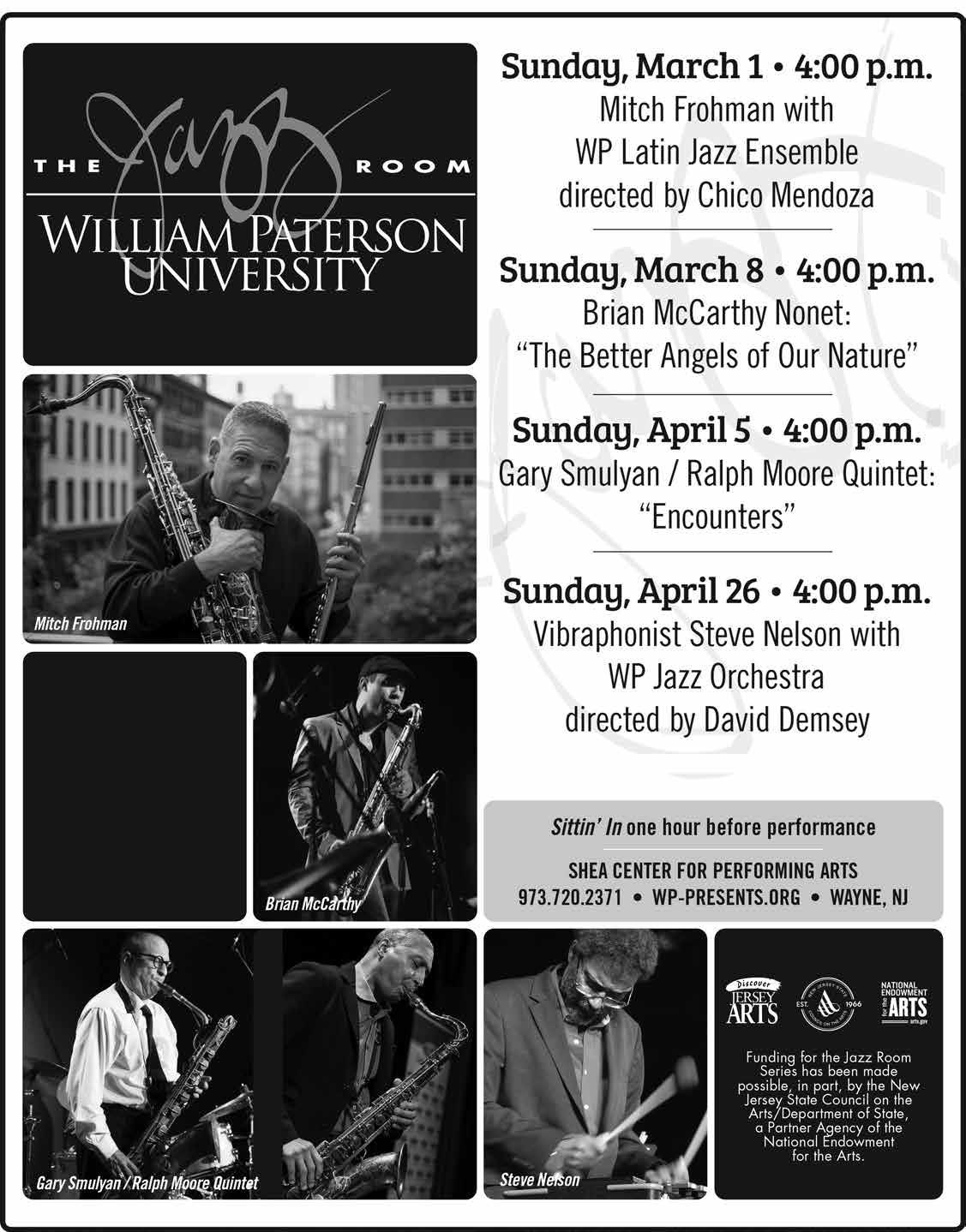

March / April 2020 11
From the Rolling Stones to Roy Haynes: Evan Sherman’s Future Has Been Shaped by the Past
By Sanford Josephson
In November 2001, Rolling Stones drummer Charlie Watts brought a jazz tentette into New York’s Blue Note jazz club. Reviewing the performance, jazz critic Ira Gitler pointed out that, “I’m sure many of the Blue Note’s patrons were Charlie Watts’ fans who showed up because of his Stones’ association. I don’t think anyone, jazzers or rockers, was disappointed in the music.”
At one of the performances during the sixnight run, nine-year-old Evan Sherman from Millburn, NJ, was in the audience with his parents. “My parents loved the Rolling Stones,” he told me, “so when I was four years old I was impersonating Keith Richards and Mick Jagger.” After the Blue Note performance, Charlie Watts, Sherman said, became “one of my first jazz heroes. That opened me up to jazz.”
Nine years later, the Star-Ledger reported that Sherman, then a junior at Millburn High School, had “traded in his rock ‘n roll chops for some jazz finesse.” He was in Los Angeles, leading a 17-piece big band -- one of 28 high school students from around the country chosen to perform at Grammy Week events. Sherman went on to attend the Manhattan School of Music and, today, is the leader of his own big band, which performed at the New Brunswick Performing Arts Center on December 20 at a concert presented by the New Brunswick Jazz Project, sponsored in part by the New Jersey Jazz Society.
Roy Hargrove “was one of my top, most influential mentors. When I first heard his records, I fell in love with his music.”
In January, he and Montclair-based pianist Emmet Cohen played four nights on college campuses in the Midwest with veteran tenor saxophonist Benny Golson. He was also part of the band led by trombonist Mariel
Bildsten that paid tribute to Duke Ellington and Count Basie on January 20 at the Morris Museum’s Bickford Theatre. Then, in February, Sherman and Cohen appeared for six nights with legendary bassist Ron Carter at the Village Vanguard. In 2018, they recorded Master Legacy Volume 2 Emmet Cohen Evan Sherman Featuring Ron Carter on the Cellular Live label. (See Talking Jazz with Emmet Cohen in the November-December 2019 issue of Jersey Jazz).
“By the time I was 13,” Sherman said, “I decided I wanted to do this for my life. Growing up in New Jersey, I was able to go to New York City. The first time I went to Dizzy’s Coca Cola, I was 14, and I saw Roy Haynes play. I was always attracted to seeing the old guys play -- James Moody, Cedar Walton. At the Village Vanguard, Cedar Walton would walk by me and say, ‘There’s the student of the week.’ Emmet and I used to see Cedar Walton together, and we would learn his songs together. Talking to Benny Golson is something I cherish. It had always been a dream to play with these guys. It’s like a basketball player who gets to play with Michael Jordan or Kobe Bryant.”
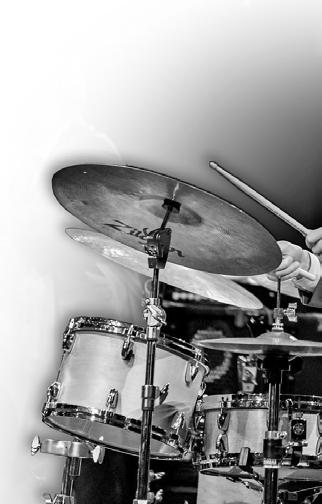
Sherman’s band at the NBPAC was a mixture of young lions (and lionesses) and veterans. There was trombonist Frank Lacy who played with Dizzy Gillespie and Art Blakey . . . tenor saxophonist Patience Higgins, a 20-year-veteran of the Duke Ellington Orchestra who has played with pianist Barry Harris and vocalists Dee Dee Bridgewater and Cleo Laine . . . and trumpeter James Zollar, who studied under Woody Shaw, recorded with Tom Harrell and is currently a member of the Duke Ellington Orchestra.
Then, there were the rising stars, among them: pianist Davis Whitfield, alto saxophonist Sarah Hanahan, bassist Marty Jaffe, and trumpeter Jumaane Smith. Whitfield, originally from Jersey City, and Sherman met when they were in high school. “We played every Sunday at the Jazz Standard youth program. (The Jazz Standard Youth Orchestra is a performancedriven program that gives young jazz
musicians the opportunity to perform regularly on Sunday afternoons during the school year at the New York club). We made a demo tape and went around to about 20 restaurants in New Jersey. Finally, Samurai Sushi in Livingston gave us Saturday night every week. We got free sushi and very little money, but it helped us learn how to play, and we’d have great people come and play with us. We did that for about three years.”
Hanahan, who grew up in Marlborough, MA, attended the Jackie McLean Institute of Jazz within the Hartt School of Music at the University of Hartford. Now residing in New York City, she was introduced to jazz by her father, who plays drums. She was lead alto saxophonist in her high school jazz band and studied at the Hartt School under saxophonists Javon Jackson and Abraham Burton. Hanahan is also a member of the Diva Jazz Orchestra.
Smith, from Detroit, played lead trumpet at the New Brunswick concert. “He plays a lot of the more challenging things that a lot of trumpeters in New York can’t,” Sherman said. On January 21, Smith released a CD, When You’re Smiling, on the Zinn Music label. In addition to the title tune, it features other standards such as Cole Porter’s “I’ve

12 March / April 2020
RISING STAR

Got You Under My Skin”, “A Kiss to Build a Dream On” (Bert Kalmar, Harry
Ruby, Oscar Hammerstein II), and Arthur Johnston’s “Pennies From Heaven”.
Jaffe has a Master of Music degree from the Juilliard School where he was a member of the Juilliard Jazz Ensemble. “His father, Andy Jaffe,” said Sherman, “taught at Berklee in the ‘80s and was Frank Lacy’s professor. Marty was hearing Cole Porter when he was an infant. He’s a great reader and plays with a soft feel. He’s very soft spoken. A lot of people haven’t heard of him yet.” Hanahan and Jaffe joined Sherman as members of Mariel Bildsten’s septet on January 20.
Another of Sherman’s heroes is the late trumpeter Roy Hargrove whose composition, “Dream Traveler”, was part of the New Brunswick repertoire. Hargrove, he said, “was one of my top, most influential mentors. When I first I heard his records, I fell in love with his music. Davis and I would go to late jam sessions at Smalls. Roy would remember us. He would help me get up at the jam sessions. I saw him whisper into this guy’s ear, ‘Evan on drums.’ To have him get on my side like that was such a boost to my confidence. When I was 17 years old, he said to me, ‘I can’t wait to hear

you when you’re 23.’ I’d see him once or twice a year, but when I was 23, I got a call from his manager, asking, “Can you play with Roy Hargrove’s band?’ I had listened to his big band every single day from my senior year in high school. He hadn’t heard me in awhile, but he was thankful I had learned his music. I did some touring with him in Europe and around the U.S. I’m constantly reflecting on our time together and digesting a lot of things he imparted.”
Sherman feels it’s a challenge to introduce young people to the music. “The industry of promoting it is decades old,” he said. “There are becoming new ways of promoting it. The key is to bring people in without dumbing it down to turn off the people who already know it. I call that ‘edutaining’. I think of the great jazz musicians as great storytellers. You have to make it an emotional journey. Young people will go to a warehouse in Brooklyn and party to dance
music. I would like to put something like that on using elements of so-called jazz music.”
Sherman has led his own big band for 5 1/2 years. “People have been asking me,” he said, ‘when are you going to record?’ I feel like once we have a recording, that will open up some more performance opportunities. We have almost 200 numbers in our library.”
Regardless of where his career takes him, it is clear that Sherman will always maintain a special reverence for the music’s legends. During a recent gig at The Django in Tribeca, Sherman looked up to see Roy Haynes in the audience. “He was singing along to the old Jimmy Lunceford arrangements. He likes ‘Cute’ (memorably arranged by Neil Hefti for the Count Basie Orchestra). He started playing it with a knife on the table. I have a picture of him with Mingus and Monk and Bird.”
The Future of Jazz: On Display in Morristown
Audience members at the Morris Museum’s Bickford Theatre on January 20 left feeling encouraged that the future of jazz is in good hands. Joining rising stars such as Sherman, Hanahan and Jaffe in trombonist Mariel Bildsten’s septet were pianist Sean Mason, tenor saxophonist Ruben Fox, and the “veteran” of the group, trumpeter Bruce Harris.
The concert was dedicated to the music of Duke Ellington and Count Basie, and Bildsten adroitly mixed recognizable standards with more esoteric pieces associated with these two jazz giants. The concert opened with Ellington/Billy Strayhorn’s “Take the A Train” and was followed by Frank Foster’s “Shiny Stockings”, a Basie favorite. Some of the lesser known selections were: Ellington’s “Black Beauty”, written in honor of Florence Mills, a 1920s vocalist known as “The Queen of Happiness”; Frank Wess’ “Senator Whitehead”, featured on the 1962 Impulse album, Count Basie and the Kansas City 7; Ellington’s Lady of the Lavender Mist, originally played by Ellington in 1952 during a Pacific Northwest tour and recently introduced to Bildsten by alto saxophonist Hanahan; and “Boy Meets Horn”, co-written by Ellington and trumpeter Rex Stewart. Stewart, Cootie Williams, and Ray Nance were the Ellington trumpet soloists in the early 1940s, and all, I’m sure, would have approved of Harris’ virtuoso solos on this tune.
Other highlights included:
Jimmy Van Heusen and Johnny Burke’s “Polka Dots and Moonbeams”, often played by Lester Young with Basie, but here given a Houston Person-like interpretation from Fox, a very talented tenor saxophonist who last year presented late-night Ellingtonia sessions at Dizzy’s Club Coca Cola and is an alumnus of Wynton Marsalis’ Young Stars of Jazz Ensemble.
A showstopping rhythm section-only performance of Ellington’s “I Got It Bad and That Ain’t Good” followed by his “Dancers in Love” that displayed Mason’s Tatumesque style, morphing into a Fats Waller-like stride, to the audience’s delight. Mason, only 21, has also played with Marsalis’ Young Stars Ensemble and appeared with Marsalis’ quintet last November at Minton’s Playhouse in Harlem.
Bildsten’s moving duet with Jaffe on the Ellington/Barney Bigard classic, “Mood Indigo”, and Sherman’s powerful drumming on the finale, Juan Tizol’s “Caravan”.
The refreshing aspect of this concert, in addition to the excellence of the musicians, was the pure joy expressed by everyone on stage, a passion and excitement that permeated the entire audience. This is what jazz is [or should be] all about. --SJ
March / April 2020 13
Evan Arntzen and Jon-Erik Kellso Lead a Quintet, Performing Selections From Their Album, Jazz Crush
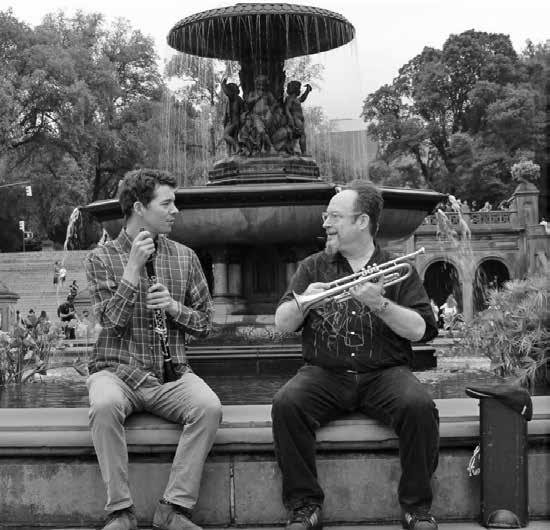
One of Evan Arntzen’s missions in life is to “listen to as much music as I can, from the beginnings in the early 20th century right up to current styles and trends.” The saxophonist/clarinetist has “spent hours listening and internalizing the playing styles of Jimmie Noone, Barney Bigard, Sidney Bechet, Edmond Hall, Benny Goodman, and Pee Wee Russell -- amongst others -- on clarinet; and Lester Young, Coleman Hawkins, Chu Berry, Dexter Gordon, Charlie Parker, Johnny Hodges, John Coltrane, Sonny Rollins, Joe Henderson, and Wayne Shorter -- amongst others -- on saxophone.
“I’m also inspired by and learn from my living predecessors on my instruments,” he continued, “and have enjoyed relationships with some of my idols.” Those heroes include Evan Christopher, Harry Allen, Ken Peplowski, and Paquito D’Rivera.
On Monday, April 6, Arntzen will join forces with trumpeter JonErik Kellso to lead a quintet at the Morris Museum’s Bickford Theatre. Arntzen and Kellso have performed together for years with the EarRegulars on Sunday nights at the Ear Inn in lower Manhattan and as members of Vince Giordano’s Nighthawks. At the Bickford, they will play some selections from their recent album, Jazz Crush, self-released in 2019.
Jazz critic Will Friedwald, writing in City View Travel Guide last July, called Jazz Crush “an ingenious collection, not only of tunes (both good-old-good-ones and Arntzen originals) but of classic jazz styles . . . It’s the most fun listening to a new album that I’ve had all year thus far . . .”
Arntzen moved to New York from Vancouver, British Columbia, in 2014 and has become an integral part of the hot jazz scene in the city. It’s a continuing challenge, he feels, to draw younger audiences for traditional jazz outside of New York City. “I think shelling out money
to go to a concert in a theater is a tough sell to anyone who hasn’t heard that kind of music before,” Arntzen said. “You have to bring the music to where the young people are already and then invite them to experience it elsewhere. It’s been my experience that if young people hear good jazz, and, especially, if they see other people -- musicians and listeners -- enjoying and getting excited about the music, they will like it and get into it immediately. But, they have to know where to find it, which means musicians and jazz societies have to get into the 21st century and engage people online so that it’s accessible.”
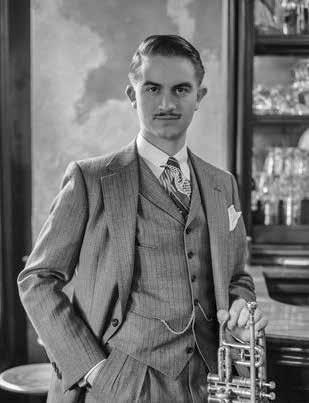
On March 6, trumpeter Mike Davis will return to the Bickford with his annual Bix Beiderbecke’s Birthday Bash. Davis is the leader of The New Wonders, a septet specializing in the jazz of the 1920s. A graduate of the Manhattan School of Music, he appears in New York City with a variety of traditional jazz artists including clarinetist/saxophonist Dan Levinson and trombonist Emily Asher.
The Bickford jazz concerts are held from 7:30-9 p.m. Tickets are $18 for museum members; $20 for non-members. They can be ordered at morrismuseum.org/jazz or by calling (973) 971-3706. The NJJS is a proud media sponsor of the Morris Museum/Bickford series.


14 March / April 2020 JAZZ
THE BICKFORD
AT
Mike Davis
Photo by Jane Kratchovil
Evan Arntzen, left, and Jon-Erik Kello on the Jazz Crush album cover.
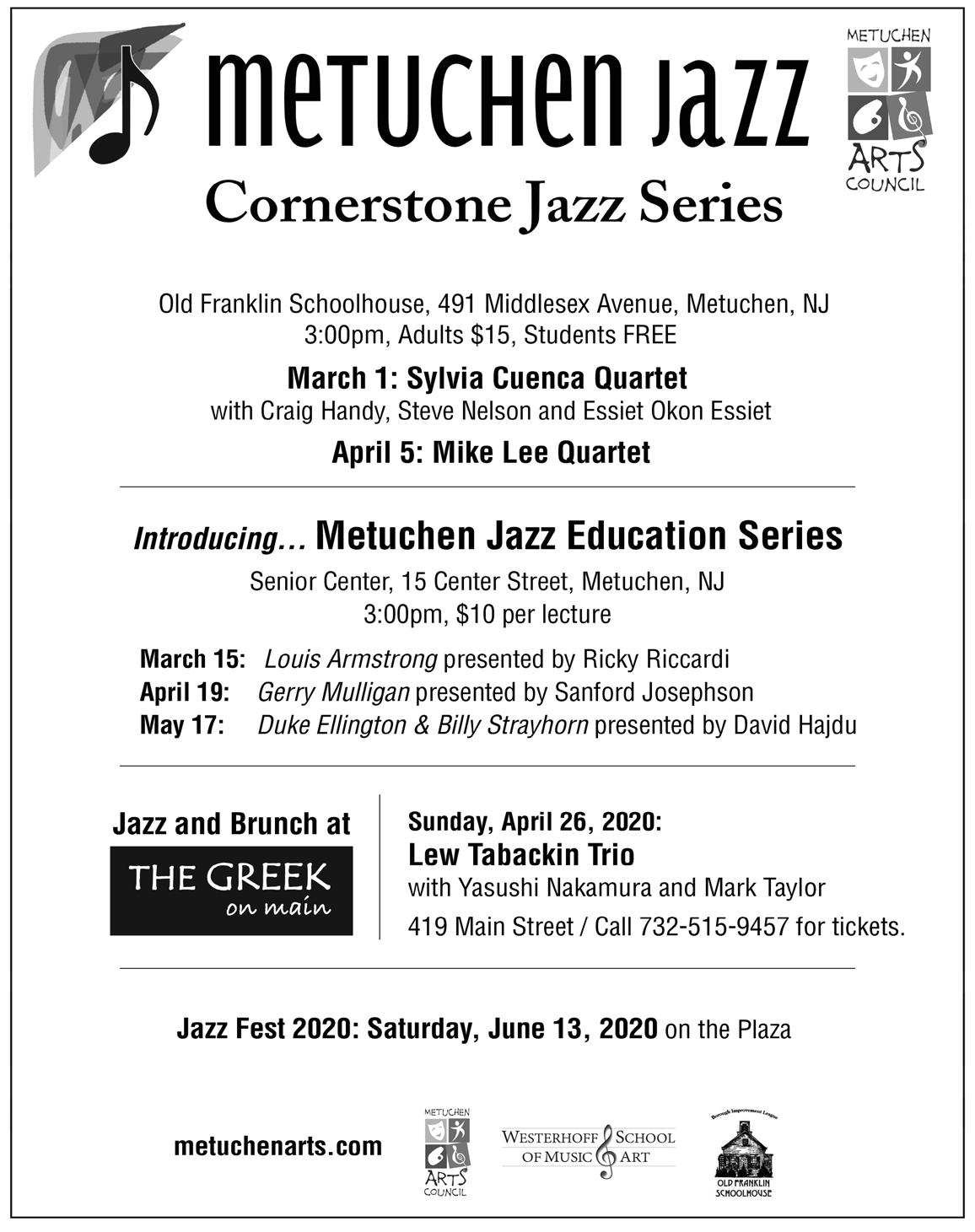

March / April 2020 15
Metuchen Arts Council Launches Educational Series
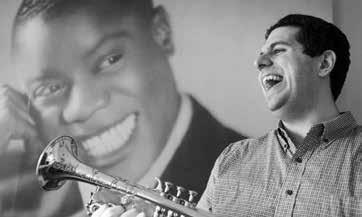
The Metuchen Arts Council will present “Metuchen Jazz -- Education Series 2020” its first-ever educational series dedicated to educating the public about jazz. The series this year will include six sessions, beginning at 3 p.m. on Sunday, March 15, with a presentation called “Louis Armstrong 101: The Wonderful World of Satchmo”, presented by Ricky Riccardi, Director of Research Collections for the Louis Armstrong House Museum and author of What a Wonderful World: The Magic of Louis Armstrong’s Later Years (Vintage: 2012).
On Sunday, April 19, the presentation will be “Jeru’s Journey: The Life and Music of Gerry Mulligan” by Sanford Josephson, author of a book by the same name, published in 2015 by Hal Leonard Books. Josephson is also Editor of Jersey Jazz and Vice President of Publicity for the New Jersey Jazz Society. Riccardi has written a second book called Heart Full of Rhythm: The Big Band Years of Louis Armstrong, to be released this year by Oxford University Press. He also has an
online blog called “The Wonderful World of Louis Armstrong (dippermouth.blogspot. com) and has given lectures on Armstrong at venues around the world. Riccardi has taught a graduate course, “Music of Louis Armstrong” at Queens College and a course on Armstrong at Jazz at Lincoln Center’s Swing University. He has co-produced several Armstrong reissues, is a working jazz pianist and co-hosts the Jazz on a Sunday Afternoon series at the Jay and Linda Grunin Center for the Arts in Toms River. He also resides in Toms River. Thomas Cunliffe of Jazz History Online has called Riccardi “the 21st century’s foremost expert on Louis Armstrong.”
Josephson has written another book, Jazz Notes: Interviews Across the Generations (Praeger/ABC-Clio: 2009) and has written several articles about jazz in publications ranging from the New York Daily News to American Way Magazine. A resident of Manchester, NJ, he is also a co-host of the Grunin Center’s Jazz on a Sunday Afternoon series. His presentation will trace Gerry Mulligan’s life and career from his early days arranging for big bands to the end of his life when he was revered and recognized as one of the true giants of American music. The New York City Jazz Record’s Ken Dryden called Jeru’s Journey “remarkable, creating a detailed portrait of the perennial pollwinning baritone saxophonist, noteworthy bandleader, composer and arranger . . .” Other presentations in the series will be: “Ellington and Strayhorn: Alone and Together” by David Hajdu, Sunday, May 17
NJJS Receives Grant for ‘Generations of Jazz’ From Summit Area Public Foundation
“Nat King Cole @100 (NKC100)” by Will Friedwald, Sunday, September 20
“An Informal Survey of the Great Baritone Saxophonists” by Frank Basile, Sunday, October 18.
The November 15th presentation will be announced at a later date.
The series is being held at the Metuchen Senior Center, 15 Center St., Metuchen. Admission is $10. For more information, please email Lynne Mueller at lmueller22@earthlink.net or Noal Cohen at bopmeisternc@gmail.com.
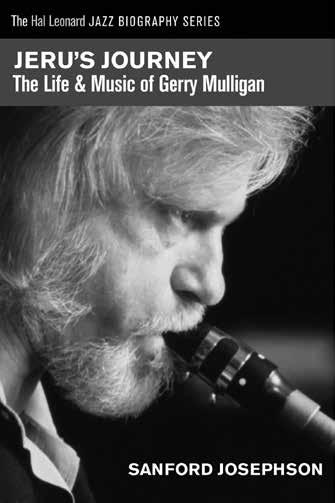
The Board of Trustees of the Summit Area Public Foundation has approved a grant to the New Jersey Jazz Society in the amount of $2,850 for “Generations of Jazz”, the NJJS’ traveling jazz history program.
The Generations of Jazz program is a traveling jazz history presentation. Around 75 minutes in length, it includes a quintet of experienced musician-narrators who survey some of the music’s highlights throughout the decades -- offering a definition of jazz, a look at its instrumentation, an examination of some of its history, and some live performances. A question-and-answer session follows the musical performance.
Julie Keenan, SAPF president, said the foundation is, “proud to support first-time grantee New Jersey Jazz Society. NJJS’ Generations of Jazz program, which will be presented at local area libraries, will offer residents a unique opportunity to learn about and experience jazz.”
SAPF is a community foundation that fosters philanthropy in the Summit, NJ, area by identifying local needs and offering donors flexible ways to make a difference in the lives of their neighbors. During the past 10 years, SAPF has awarded more than $5.2 million to 107 nonprofit agencies. SAPF awards an average of 38 grants per year.

16 March / April 2020 JAZZ IN METUCHEN
Ricky Riccardi with Louis Armstrong’s trumpet, as Pops looks on.
Photo by Yoni Brook
Photo by Franca Roti Mulligan


March / April 2020 17
Houston Person
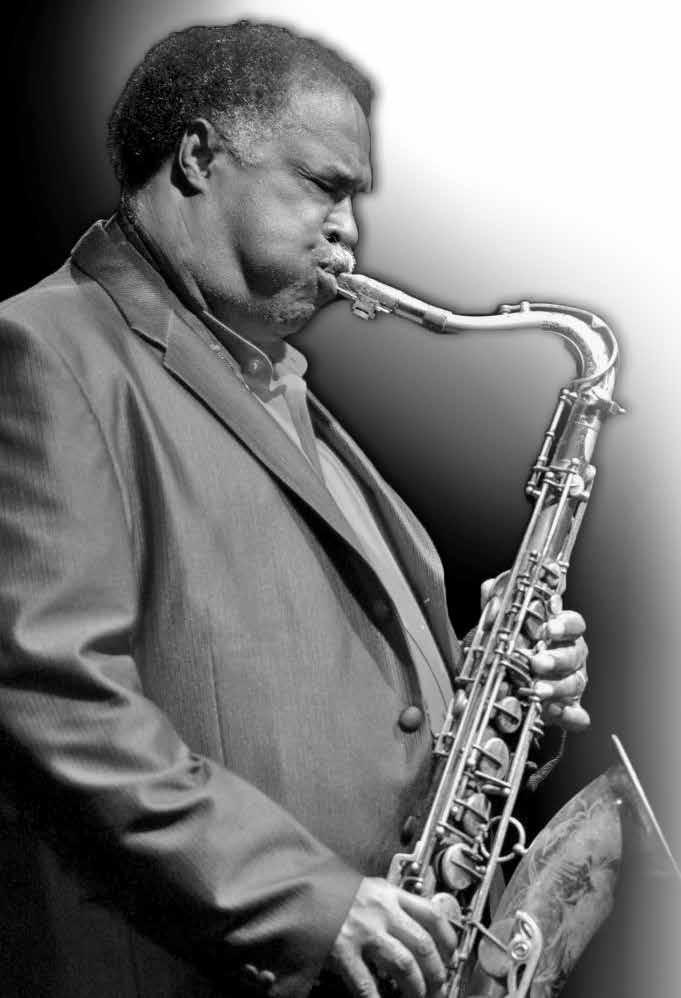
Young Lions and Seasoned Veterans Mix It Up In Several Different ‘Musical Conversations’
By Priscilla Life
Thursday, January 24, in Wilmington, NC, the North Carolina Jazz Festival opened the first night of its 40th Birthday celebration with a bang! The SRO crowd at the Hotel Ballast, was first treated to an impressive set by drummer John Hill and his trio, local talent from the University of North Carolina. The “bang” arrived in the persons of Emmet Cohen, young jazz pianist extraordinaire, from the Big Apple with his trio, accompanied by Veronica Swift, a rising star in the jazz vocalist scene. They had the crowd on their feet and begging for more by the end of the set.
Friday night, the 2020 NCJF All-Stars took the stage forming seven distinct sets each directed by one of the musicians. Ben Polcer, (trumpet), led the audience on a trip through New Orleans classics . . . but that would be a natural because Polcer is one of the top young bandleaders in NOLA. He was supported by
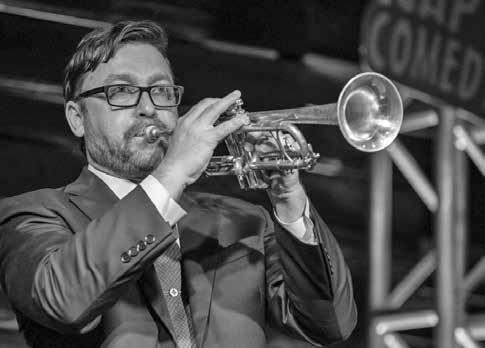
Adrian Cunningham (clarinet, saxophone and flute), Dion Tucker (trombone), Nate Najar (guitar), Champian Fulton (piano), Herman Burney (bass) and Chuck Redd (drums). Now, some folks would rather see groups that play together all of the time, but if you keep in mind that jazz music is historically a “conversation” between musicians, this festival structure makes all the sense in the world, with new and fresh “conversations” being created as the groups change and evolve, creating a series of chemistries.
The theme of the festival for 2020 was “The Young Lions of Jazz”, and we had plenty of new stars, but we also cherished our returning musicians, some of whom who have been entertaining us for years (even though they aren’t that old). One of those returning to our stage this year was the inimitable Houston Person. Every saxophonist has his or her own style, but Person blows such a smooth horn, it’s like riding a magic carpet through the tune. When you put him together with Rossano Sportiello (piano), Nicki Parrott (bass) and Chuck Redd (drums), it truly is magical.
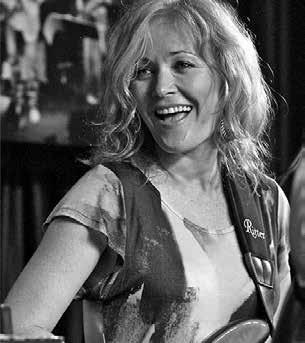
The goose bump moments came on Saturday, the final night of the Festival. Parrott led a set backed up by Person, Bruce Harris (trumpet), Fulton (piano and vocals) and Chris Gelb (drums). Midway through the set, she “kicked” the “boys” off the stage, and she and Fulton performed a duet of what they called a Blue Moon/Moonglow “mash-up”, trading lyrics from each song and finally blending their voices at the end. Standing ovation time.
The second goose bump moment arrived in the final set of the Festival. Burney called Houston back up to the stage to perform a duet of bass and tenor sax of “untitled blooz for the 40th anniversary of the North Carolina Jazz Festival” before bringing most of the other 2020 NCJF All-Stars on stage for a rousing series of final tunes.
And just like that, the 2020 North Carolina Jazz Festival was over. Three nights of some of the best jazz in the country . . . until next year February 4, 5 and 6, 2021, in Wilmington.
Y’all come!

18 March / April 2020
FESTIVAL
NORTH CAROLINA JAZZ
Nicki Parrott
Ben Polcer


March / April 2020 19
CHICKEN FAT BALL
Rossano Sportiello Transforms Frederic Chopin Into Fats Waller
“My idea,” explained pianist Rossano Sportiello to Jersey Jazz, “is to utilize entire pieces or just themes by Chopin, expose them according to the score, and then turn them into structures as a basis for jazz improvisation in the idioms of classic jazz -- from stride to bebop. The result is very much appreciated by audiences around the world . . . “ When Sportiello played “Chopin’s Waltz in C# Minor” at the annual Chicken Fat Ball held on January 5 at The Woodlands in Maplewood, he brought down the house. He transformed a traditional classical performance into a stride romp. Or, put another way -- he turned Frederic Chopin into Fats Waller.
Sportiello was one of several traditional jazz superstars at this year’s CFB. The others included trumpeter Jon-Erik Kellso, trombonist/trumpeter Randy Reinhardt, tenor saxophonist Harry Allen, guitarist Frank Vignola, drummer Paul Wells, bassist Gary Mazzaroppi, and multi-reedist Peter Anderson, subbing for the previously-scheduled Ken Peplowski.
The afternoon was filled with jazz classics and tunes from both the American Songbook. Other selections included Clarence and Spencer Williams’ “Royal Garden Blues”, Hoagy Carmichael’s “Stardust”, Terry Shand’s “Love Lies” from the 1950 album, Jump, with La Vere’s Chicago Loopers, a group that included Jack Teagarden. William Benton Overstreet’s “There’ll Be Some Changes Made”, and Irving Berlin’s “All By Myself.”

Sportiello’s Chopin/Waller metamorphosis was a big hit in Europe last year. “I was invited to perform in Poland last November, and, to my surprise, the Polish people loved it!” He toured the United Kingdom last May and June and, when interviewed by London Jazz News, said his concerts would “probably be 80-90% jazz and regular standards, but there is always present in each performance a bit of classical music by surprise.” According to LJN, “Barry Harris once described Sportiello as the best player of stride piano he had ever heard.”
Among other highlights: Kellso and Reinhardt’s duet on Lil Hardin Armstrong’s “Struttin’ with Some Barbeque” (of course, made famous by Louis), extemporaneously tagged with Louis’ “Cornet Chop Suey” coda . . . Allen’s exquisite a capella solo on “The Summer Knows”, theme from the movie, Summer of ‘42 . . . and Juan Tizol’s “Caravan”, which enabled Wells to stretch out on the drums.
It’s hard to pin Sportiello down regarding his influences. He reeled off a list of 13 to Jersey Jazz. In addition to Waller and Harris, they were: Teddy Wilson, Earl Hines, Art Tatum, Erroll Garner, Bud Powell, George Shearing, Hank Jones, Tommy Flanagan, Dave McKenna, and Ralph Sutton, “among others.”


20 March / April 2020
From left, Rossano Sportiello, Frank Vignola, Gary Mazzaroppi, Peter Anderson, Harry Allen, Paul Wells, Jon-Erik Kellso, and Randy Reinhardt.
Photo by David Dilzell


March / April 2020 21
‘Billie & Blue Eyes’ Returns to Princeton
By Schaen Fox
This past December 13th and 14th Catherine Russell and John Pizzarelli packed the McCarter Theatre Center’s Berlind Theater in Princeton for two nights with a tribute to Billie Holiday and Frank Sinatra. We caught the first performance, as that featured a 15-minute pre-show conversation with them and WRTI Radio’s Bob Craig. When the three appeared onstage, John got our attention with, “You are probably wondering why I called you here tonight.” When asked if having the great guitarist Bucky Pizzarelli for his father was critical to his career path, he earnestly responded, “If he were a plumber, I’d be a plumber.” Craig asked Russell about her years as a backup singer, and Cat quickly pointed out that she still does it. When Craig mentioned that her mother, the multi-talented Carline Ray, had been proficient on both bass and guitar, Pizzarelli quickly added that she also had advanced degrees from both Juilliard and the Manhattan School of Music. After the talk, Pizzarelli began the show. He has a magnetic stage presence, whether talking, joking, singing or playing guitar. I have heard him tell some stories several times, but he always adds new facets to the gems, so my enjoyment never wanes. Russell never tries to compete, but is content to enjoy his often-self-deprecating humor with the rest of us. As he put it, she had no need to try to copy his schtick, because, once she began singing, we would wonder why he was still on stage. A few years ago, she told me they had developed four different shows with the same title. I wonder how many they have now.
Backup duty belonged to Pizzarelli’s regulars, Konrad Paszkudzki on piano, and Mike Karn on bass. As always, their work was flawless. The
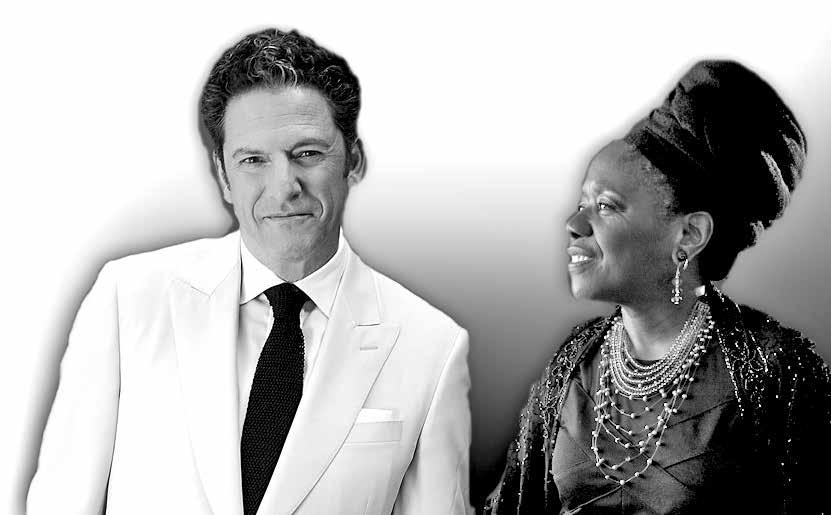
foursome presented a good number of expected selections, done in full. Among them were Sinatra standards such as “I’ve Got the World on a String,” “In the Wee Small Hours,” “Ring-A-Ding-Ding,” “You Go to My Head,” “Ghost of Yesterdays.” I was keeping count until they went into a medley that seemed to include most classics associated with Lady Day and Frank. It was all impressive and enjoyable. To conclude, Russell selected Holiday’s “With Thee I Swing,” and the audience roared their approval. After the encore of “Hit That Jive Jack” the two stars graciously met with their fans. She to sign her CDs and chat, he to just to talk with all who wanted to talk or get a photo, because his CDs had never arrived. They are marvelous artists that truly give their all.
On March 14th and 15th, The Hot Sardines will be appearing at the McCarter Theatre Center; and on April 17th, pianist/composer Arturo O’Farrill will be leading his Afro Latin Jazz Orchestra. For more information, log onto www.mccarter.org.
Greg Bryant Named New Host of WBGO ‘After Hours’
Greg Bryant has been named the new overnight host for WBGO “After Hours”, succeeding Brian Delp, who is now the midday host. Bryant officially began the week of January 6.
While still in high school at age 14. Bryant was given the chance to host a weekly jazz radio show on WFSK-FM, the Fisk University station that served the north Nashville, TN, community. While pursuing a Mass Communications degree at Middle Tennessee State University in Murfreesboro, TN, Bryant earned a position at WMOT-FM, which was Tennessee’s only full-time jazz station and NPR affiliate.
He then moved on to complete a Master’s degree in Broadcast Journalism at Northwestern University in Chicago. Between studies every weekend, Bryant was a constant presence in such Chicago area venues as The Jazz Showcase, The Green Mill, Orchestra Hall and The Velvet Lounge. This allowed him to meet and hear many of his musical heroes – saxophonists Lou Donaldson and Sam Rivers, bassist Percy Heath, trumpeter Clark Terry, and drummer Jack DeJohnette. While at Northwestern, he also hosted a weekly morning show on WNUR-FM.
At the completion of his studies, Bryant returned to Nashville where he worked in public relations, launched a performance career as a bassist and returned to radio hosting a weekly jazz showcase on WFSK called, “Premium Jazz.” During this tenure, he interviewed such luminaries as pianist Herbie Hancock, tenor saxophonist Sonny Rollins, and bassist Ron Carter.
After leaving the station to concentrate on performing and touring as a musician and sideman, he cultivated a local concert series where he brought renowned improvisational musicians to the Nashville area including organist Dr. Lonnie Smith and guitarist Peter Bernstein.
In February, Bob Ottenhoff, WBGO’s inaugural Founder and Station Manager, agreed to serve as interim President and CEO, succeeding Amy Niles, who resigned.
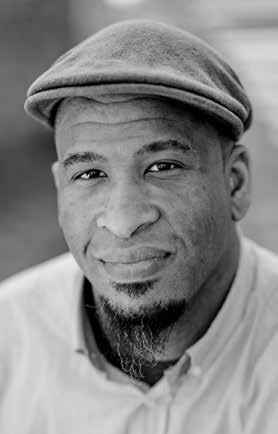

22 March / April 2020 JAZZ AT MCCARTER
Photo Courtesy of McCarter Theatre Center.
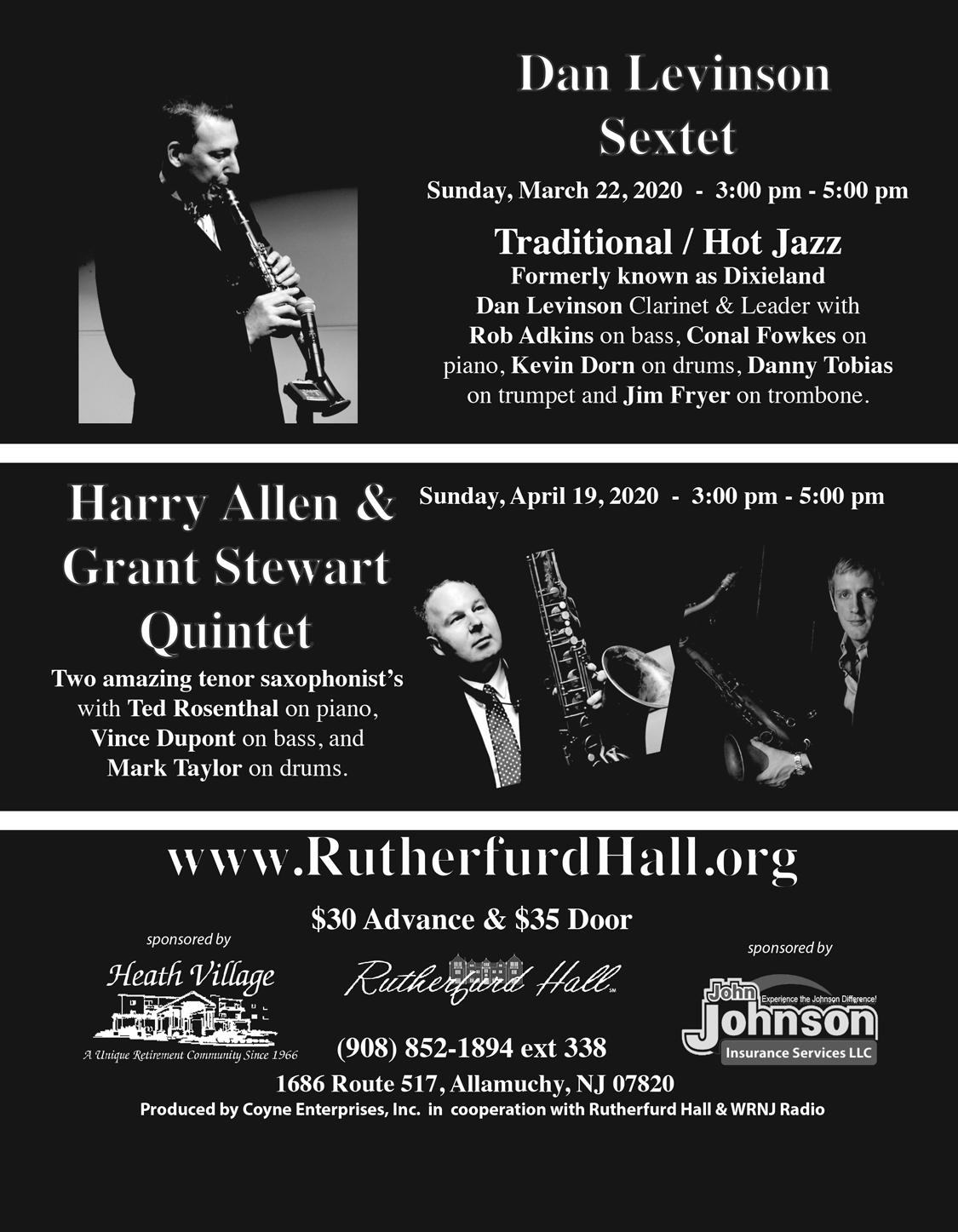

March / April 2020 23
JAZZ ON A SUNDAY AFTERNOON
Lucia Jackson: Combining Vocals and Modern Dance
Roots Music Report’s Joe Ross called Lucia Jackson’s 2018 self-produced album, You and the Night and the Music “a wonderful showcase of her impressive singing talent. She and her first-rate quartet of accompanists cover many musical moods with American Songbook standards, creatively arranged by her father, guitarist and producer, Ron Jackson.” Jersey Jazz’s Joe Lang wrote that, “This should be the first of many albums.”
A graduate of the Alvin Ailey School of Dance, Jackson has created her own hybrid of modern dance and jazz vocalizing. This combination fuses the motion of modern dance with the traditions of jazz singing into an exciting art form.
At 3 p.m on Sunday, March 22, Jackson will perform as part of the JAZZ on a SUNDAY afternoon series at the Jay and Linda Grunin Center for the Arts in Toms River. Other members of her band, in addition to her father, are pianist Yago Vazquez, bassist Matt Clohesy, and drummer Corey Rawls.
You and the Night and the Music includes classics such as Cole Porter’s “Just One of Those Things” and Duke Ellington’s “Sophisticated Lady”. There are also new pop tunes, such as Julia Michaels’ “Issues”, an original composition, “Feel the Love”, and tributes to The Beatles and Frank Sinatra with “And I Love Him” and “I’m a Fool to Want You”, respectively.
Jackson grew up in Spain and draws upon her musical roots by integrating flamenco and tango into her interpretation of jazz.
The New Jersey Jazz Society is a proud media sponsor of the JAZZ on a SUNDAY afternoon series. The Grunin Center is located on College Drive on the Ocean County College campus in Toms River. Tickets can be ordered by visiting grunincenter.org, visiting the box office, Monday-Friday, 10 a.m.-5 p.m., or calling (732) 255-0500.
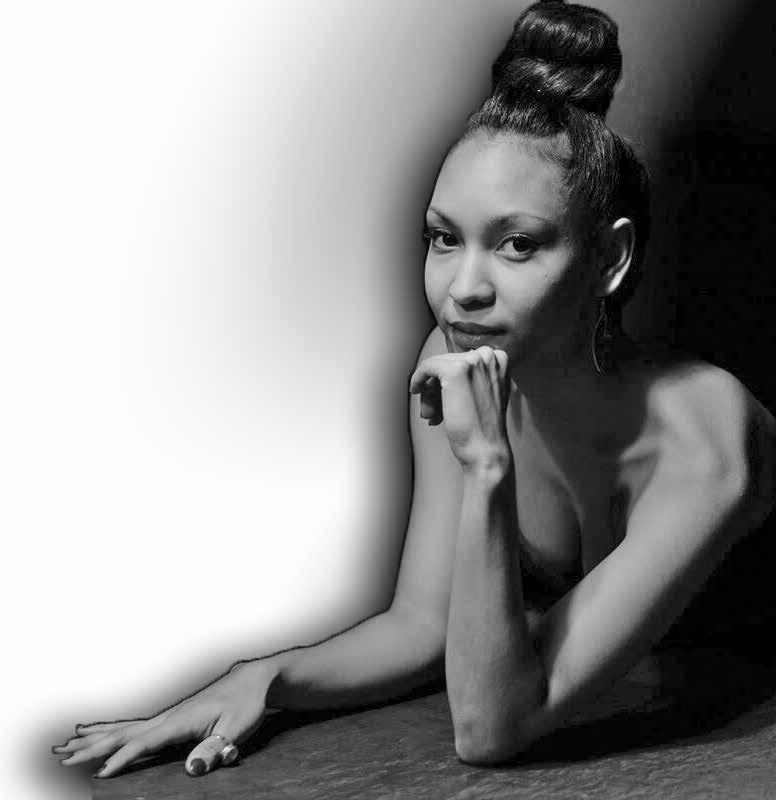
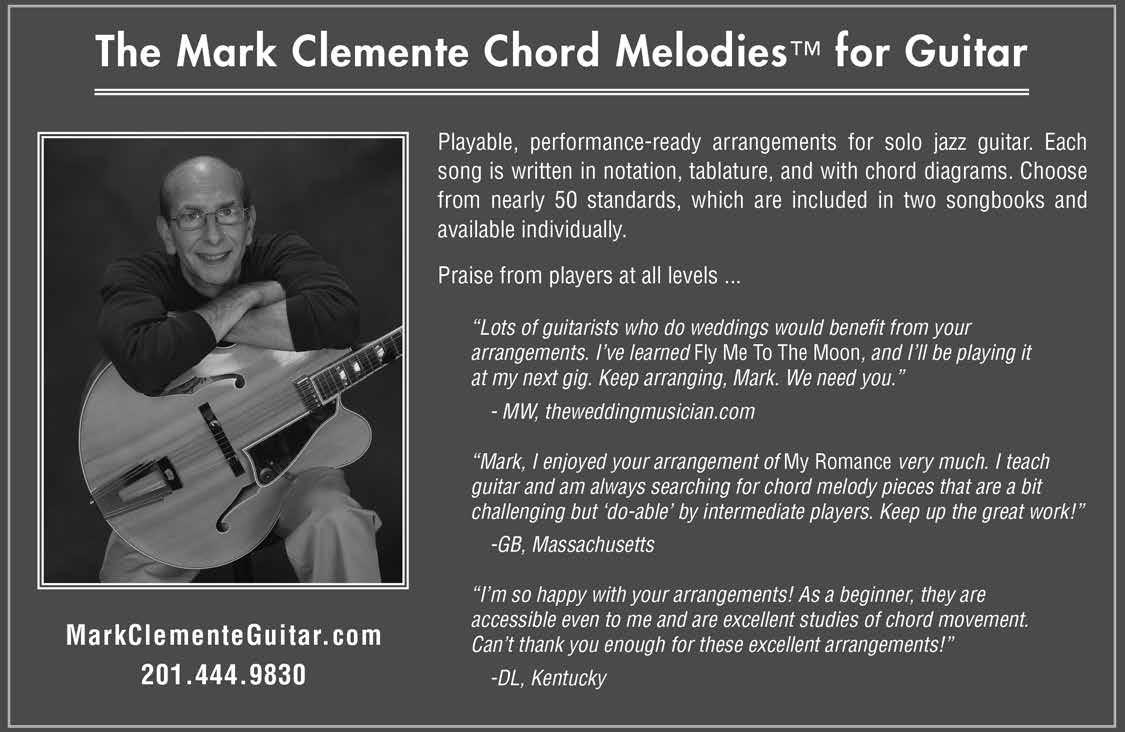

24 March / April 2020


March / April 2020 25
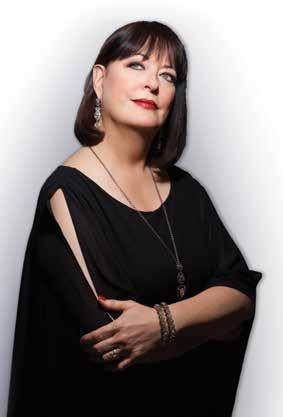 Ann Hampton Callaway
Ann Hampton Callaway
 By Sanford
By Sanford
In 2018, Ann Hampton Callaway released an album called Jazz album titled Screenplay (Bfmjazz). Both celebrated songs introduced
JazzTimes’ Christopher Loudon described Jazz Goes to the Movies as a “gorgeous collection of giltedged standards -- Porter, Berlin, Mercer, Kern, Arlen, Carmichael, Duke, the Gershwins, Rodgers and Hart -- the oldest dating to 1926, the newest to 1950.” Wrote Jersey Jazz’s Joe Lang: Callaway infused “her interpretations with a distinct jazz sensitivity . . . a singer who is at the top of her game . . .” Broadway World named the album The Best Commercial Recording of 2019.
The Tierney Sutton Band’s Screenplay, according to AllAboutJazz’s Nicholas F. Mondello, delivers tunes “we have often heard -- but never this creatively . . . Sutton’s vocal chops and her phrasing are impeccable. Not only is she dead-on pitch, but her instrument -and the way she handles it across the dynamic spectrum -- enables her to derive new imagery from the vintage material.” JazzTimes’ Andrew Gilbert applauded Sutton for daring to try out “left-field choices . . . She drains the saccharine from ‘Hopelessly Devoted to You’ and adds real sass to ‘You’re the One That I Want’, both from Grease.”
The album received a Grammy nomination (Sutton’s ninth) for Best Jazz Vocal Performance.
On Saturday, March 28, Callaway and Sutton will join forces at the New Jersey Performing Arts Center’s Victoria Theater in a concert called “In Technicolor”, singing songs from the movies -- together and individually. They will be accompanied by the Tierney Sutton Band: Christian Jacob on piano, Kevin Axt on bass, and Ray Brinker on drums.
Callaway and Sutton have performed these songs live together three times previously -- in
Ann Hampton Callaway
After spending two years in college as an acting major, Callaway moved to New York in the late 1980s and began carving out a career as a pianist-singer, performing in piano bars and small cabarets. George Shearing encouraged her to “step away from the piano”. Shearing “felt like I wasn’t doing all I could to become a jazz singer,” Callaway recalled. “He really believed in me, and he thought I was trapped by playing by myself. I owe so much to him.”
Callaway has performed and recorded with some of jazz’s biggest stars. “Wynton Marsalis,” she said, “with his beautiful musicality thinks Ann Hampton Callaway is hip enough to play with. That’s a great honor. I’ve had such fun with great pianists such as Ted Rosenthal, Bill Charlap, and Cyrus Chestnut. I just did a concert with Ramsey Lewis. The chemistry was electrifying. One of the coolest experiences I ever had was hanging out at the Village Vanguard with Dizzy Gillespie and Jon Faddis.”
In 1996, Callaway recorded To Ella With Love (After 9 Records), a tribute to Ella Fitzgerald; and then, 18 years later she recorded From Sassy to Divine the Sarah Vaughan Project, a tribute to Sarah Vaughan, also on the After 9 label. Musicians on the Ella album included Marsalis, Chestnut, bassist Christian McBride, drummer Lewis Nash, and tenor saxophonist Andy Farber, among others. On the Vaughan album, Callaway’s accompanists included Rosenthal, drummer Tim Horner, trumpeter Randy Sandke, and saxophonist Dick Oatts.
How do you compare Vaughan and Fitzgerald? “Sarah Vaughan,” Callaway said, “has a more sensual, sultry approach than Ella, but they were beautiful complements to each other in their ability to swing and improvise, and their phenomenal artistry. Ella Fitzgerald was managed in a different way and was able to reach a broader audience through her Songbook series. Sarah Vaughan was always wishing she was more famous.”
In 1999, Callaway received a Tony nomination for Best Featured Actress in a Musicial for her performance in Swing! She wrote and sang the theme song for the hit TV series, The Nanny, and wrote songs that appeared on seven of Barbra Streisand’s albums.
Her newest tribute show is “The Linda Ronstadt Songbook”, which premiered at Feinstein’s 54 Below in 2018 and has been performed at several other venues since. “I grew up hearing Linda on the radio,” Callaway said. “I love the fact that she’s such an adventurous singer. As someone interested in celebrating the American Songbook, I couldn’t believe the Queen of Rock ‘n Roll made albums with my favorite arranger, Nelson Riddle.” Callaway was introduced to Ronstadt on the phone, and “she gave me an endorsement (to perform her music). It took me back to being an 18-year-old, listening to Joni Mitchell and Carole King. I’m getting to jump genres like she did, only in reverse. I felt so incredibly sad that someone with her talent is not able to sing anymore.” An album of songs associated with Ronstadt, Callaway said, is in the works.
26 March / April 2020 JerseyJazz
JAZZ
NJPAC
AT

The “In Technicolor” concert will be presented at 7:30 p.m. on Saturday, March 28 in NJPAC’s Victoria Theater. Tickets may be ordered by logging onto www.njpac.org.
Jazz Goes to the Movies (Shanachie Entertainment). In 2019, Tierney Sutton recorded an introduced in or associated with the movies.
Seattle, San Francisco, and Irvine, Ca. They also did it in the studio at Tacoma jazz radio station KNKX. It seemed like a natural project, Callaway said because, “We’ve known each other for years.” Jazz Goes to the Movies, she pointed out, contains “older classic movie themes from the ‘20s through the ‘50s. Tierney was doing more contemporary songs. My own shows are usually well-crafted, almost a plot line. Tierney likes to dream it up fresh every day. We’ll be mixing it up with duos and solos.”
“It’s really fun to do these concerts with Ann,” added Sutton. “It’s two different ways of approaching the music. It’s really fun for us. She’s a really great storyteller and knows the background of the music, and so do I. But we never do the same show the same way twice. There’s a certain tension between the Broadway perspective and the jazz perspective, and we’re always trying to balance that. We both balance it in a slightly different way. It’s a tension between structure and freedom. I’ve learned a lot from performing with Ann.”
Tierney Sutton
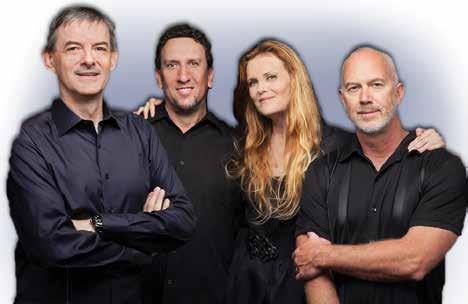
The Tierney Sutton Band has been together for 27 years. “We really are unique,” Sutton said. “I don’t know of any other musical unit that’s stayed together as long as we have with the same personnel. I think all of the band members have a similar philosophy: We definitely want to do something that hasn’t been done before -- serve the music and serve the song and challenge ourselves.”
A perfect example was JazzTimes writer Andrew Gilbert’s comments about the songs from Grease. Tierney recalled that pianist Christian Jacob wanted to arrange them for the album, “and I said, ‘What are you talking about?’ In the end, it turned out to be a wonderful opportunity. I wouldn’t have chosen those songs, although I knew them and listened to them in my youth. Christian always says a great way to arrange is to take a song that you don’t really like that much. What he did with them made me a believer.”
Sutton, who grew up in Milwaukee, majored in Russian literature and language at Wesleyan University. While in college, she had a summer job as a singing cocktail waitress at the Heidel House Resort in Green Lake, WI. “I would serve drinks and sing ‘The Battle Hymn of the Republic’ and horrible arrangements of standards. Across the street, the Mary Jaye Trio, a jazz trio, was playing at the Tuscumbia Country Club. Everything they did had integrity.” That introduced her to jazz. Then, back at Wesleyan, she discovered the jazz program, headed by saxophonist Bill Barron. “He brought in people like his brother, [pianist] Kenny Barron, and the Heath Brothers.”
From there, Sutton attended the Berklee College of Music and studied privately under saxophonist Jerry Bergonzi. After moving to Los Angeles in the early ‘90s, she formed the Tierney Sutton Band, recording her first album, Introducing Tierney Sutton on the Challenge label, in 1998. Early influences were Al Jarreau and Bobby McFerrin, but she also tried to immerse herself in instrumentalists. While doing some work with Hubert Laws, “I figured out that my sound is more like an alto flute. If you try to sound like someone else, it’s like an alto flute trying to sound like a trumpet.” Betty Carter, she said, “had such a kicking band. That’s what I learned from her. Al and Bobby had such an instrumental approach. Later, I started to study Frank Sinatra and Joni Mitchell for telling the story, reading the lyric.”
Other musical heroes include Michel Legrand and Bill Evans. Two songs on the Screenplay album were composed by Legrand -- “The Windmills of Your Mind” from The Thomas Crowne Affair and “What Are You Doing the Rest of Your Life?” from The Happy Ending. Sutton was the vocal coach for French opera singer, Natalie Dessay on Legrand’s last work, an album called Between Yesterday and Today, “a song cycle from birth to death.”
Bill Evans, Sutton said, “was one of the first jazz musicians I listened to a lot. Because I didn’t have a voice with a jazz sound, I was drawn to his light, classical touch and a lot of his quiet subtlety.”
March / April 2020 27
JerseyJazz
Josephson
The Tierney Sutton Band: From left, Christian Jacob, Kevin Axt, Tierney Sutton, and Ray Brinker.
MONTCLAIR JAZZ SCENE
Lee Family: The Beat Goes On
By Robert McGee
Jazz history is replete with talented, famous families. Jazz fans are familiar with the Marsalis family -- father Ellis and his four performing sons, all of whom have well-established careers in the jazz world. In addition, what jazz fan isn’t familiar with the Heath Brothers, The Brubeck family, or the Adderleys -- Cannonball, brother Nat and Nat’s son, pianist Nat Jr., who is a regular on the New Jersey/New York jazz scene? Jersey’s Pizzarellis are known throughout the jazz world, and Thelonious Monk and son, drummer, T.S.Monk, both hail from New Jersey. No doubt, there others that escape my memory at present.
There is a family, perhaps not as well-known -- certainly not from lack of talent -- living and working here in New Jersey. The Lee family of Montclair is a study in commitment and dedication to the great American art form known as jazz.
Mike Lee is an extremely talented tenor saxophonist who plays regularly in New York clubs and is much sought-after on the New York/New Jersey jazz scene. Currently, Mike is playing in a long running gig with pianist/vocalist Loston Harris at New York’s celebrated Hotel Carlyle. Lee’s bio lists performances at some of the country’s most well-known jazz venues, with some of the country’s most well-known jazz bands. In addition to the Carlyle, he is a regular with the Dizzy Gillespie Big Band led by South Orange resident, bassist John Lee. Mike was, for many years, the leader of the Cecil’s Big Band (at drummer Cecil Brooks’ now defunct jazz club in West Orange). In addition to his extensive performing career, he is a notable educator. As one of the original faculty members of Melissa Walker’s Jazz House Kids organization, Mike has mentored hundreds of young people, helping them perfect their respective craft. He performs at the Montclair Jazz Festival every year, with other teachers from JHK. (This year his son Julian performed with the band).
father and alto saxophonist Bruce Williams, Julián went on to Julliard to study music. He was mentored there by the Scottish baritone saxophonist Joe Temperley. After Julliard, Julian had a short stint leading the late-night jam at Dizzy’s Club Coca Cola. During this period he could also be seen in some of New York’s most prestigious jazz clubs. On May 12, 2016, I attended a tribute to Miles Davis at Jazz at Lincoln Center with Wynton Marsalis and the JALC Jazz Orchestra and was astounded to see Julian walk out on stage, saxophone in hand, to occupy a seat in the saxophone section. Unfortunately, this was the night after Julian’s mentor Joe Temperley had passed away. The ensuing tribute to Temperley’s life set a somber tone for the evening, but it may have inspired the band and Julian, as this was one of the most memorable jazz concerts I have ever attended. Julian had mixed feelings during that performance. “As excited as I was to be on stage with this great orchestra, playing this incredible music,” he said, “I know I felt and could feel the band felt a deep sense of loss having lost Joe the night before.”

Rebecca Harris Lee, Mike’s wife, is a talented musician in her own right. A professional violinist, Rebecca was born into a musically talented family. Her father is Professor of Cello at the Eastman School of Music and was a pianist with and previously taught at the Cleveland Institute Observatory of Music. Mike and Rebecca are both from the Cleveland area and met there. Rebecca’s mother, Josie Harmon-Harris, is a classically trained pianist currently residing in Montclair. It would seem there is some sort of genetic thread running through the family. All of the Lee children are talented musicians.
The oldest son Julian is an excellent tenor saxophonist, following in his father’s footsteps. Julian is currently on a 32-city tour with Mike Mwenso and the Shakes who played with and were mentored by James Brown. After attending Montclair High School and playing with the Jazz House Kids, where he studied the saxophone with his
The Lees’ younger son, drummer Matt, 18, has been on the scene since the age of eight, debuting on the main stage of John Lee’s annual Giants of Jazz Program at the age of 10. A trumpeter as well as drummer, Matt currently attends Montclair High and refined his musical talent at Jazz House Kids. He plans to pursue music as his major in college beginning this coming fall. I recall seeing Matt at a jam session with his father when he was perhaps 10 or 12 years old, and he could barely be seen over the drum kit. He sure could be heard however, as, even at that young age, he displayed a large degree of talent. He, no doubt, has a bright musical future ahead of him.
Fourteen-year-old daughter, Jacquie, is, like two generations before her, a violinist. Julian, Matt, and Jacquie all frequently perform in jam sessions run by their father at the Social Club in Montclair on Wednesday nights. The jams at the Social Club also feature a multitude of Jazz House Kid alumni and several of their mentors. In addition to Mike Lee, others who often appear are Bruce Williams, keyboardist Radam Schwartz, trombonist Steve Turre, guitarist Dave Stryker, and pianists Oscar Perez and Nat Adderley Jr. Music, not unexpectedly, has always been a part of the Lee kids’ lives from a very early age. “Rebecca and I felt that music was such an important part of their education,” said Mike, “that they had to spend a minimum of 20 minutes per day, playing music, akin to spending time learning math, science, history, and other educational subjects.”
Julian told me that at age 13 he caught the music bug while attending a music summer camp his father ran, attended by young musicians from all over the country. “Jazz music,” he said, “is not notes on a page. It is connection to people. It is life”

28 March / April 2020
Julian, Jacquie and Matt at Montclair Jazz Festival. Photo by Christopher Drukker


March / April 2020 29
An All Monk House Concert
By Schaen Fox
Since 2002, a main jazz attraction around Princeton, NJ, has been the series of gigs now called JazzNights. It is a group of house concerts hosted by Mary Wisnovsky and Maitland (Mait) Jones. There are obvious downsides to hosting such an event: all the effort in preparing for and cleaning up afterwards, plus guests can spill drinks, and knock things over. Also, there’s the story about when Bunny Berigan’s widow hosted a gathering after his funeral, and someone stole Bunny’s trumpet. That the two good friends continue, shows that the positives outweigh the negatives. In little more than the first year, they had presented Bill Charlap, Mulgrew Miller, Rene Marie, Fred Hersch and others of comparable talent and fame.
It has been a collaboration from the start, but Jones had dreamed about it for years. “It was such an obvious thing. Here we are, an hour and a half from New York, where every jazz musician in the world is, or goes through, and as long as you can come up with a reasonable paycheck, and you’re flexible about time, everyone will come; but I had been too chicken to ask anyone. Finally, I found myself at the bar in Shanghai Jazz in Madison talking to Bill Charlap. I just floated the idea, and he said, ‘Sure.’”
Wisnovsky described why, and how it works. “The most satisfying element is not only that I have the opportunity to listen to some really fabulous jazz, but that we provide the opportunity for so many others to listen and learn about jazz. The audiences have all heard some music that they might not have had the opportunity to hear before. We have Fred Hersch, and Bill Charlap, but we also have the less well-known musicians. What is very gratifying as well is supporting them. Mait’s more involved in getting the musicians and writing up the description of the coming concert. I control the email list, which is in the hundreds. I send out the announcements, coordinate the responses, answer questions, develop the attendance list, receive and bank all the money. Mait jokingly refers to me as the CFO. If we were a big business, he would be the artistic director and I would be the general manager.”
different homes around Princeton. Then, Jones relocated to a rural Hopewell property. Saxophonist Scott Robinson noted, “One thing I love about music is she takes me in so many places and unusual situations in the world. I think, ‘Oh Man! Look where music brought me today.’ It was great to play in that beautiful, quiet and peaceful house in the country.” (Scott Robinson’s Arbors Records album, Tenormore, was voted Best New Release in the 2019 JazzTimes Readers’ Poll.)

The country house, however, is not the primary attraction. Just as the perfect setting for a painting enhances its impact, house concerts offer a special allure to musicians. Kimbrough has repeatedly played that grand Steinway because, “Playing in an intimate space for an audience that is with you is the greatest experience. There is a loop between the band and the audience, a two-way conversation. We are putting energy out, and we are getting it back from them. When you feel that, there is really nothing quite like it.” Bassist Rufus Reid echoed that. “This is how the music got born,” he said. “Back in the day, guys would come over to the house and they would have rent parties with food and drink, and people would play. It was always a communal thing. The closeness of it almost puts you in the band with us as opposed to a club where there is what I call a little moat; and in a concert space there is a huge moat. There the music is different.” Robinson agreed: “Most of the time we are playing in commercial establishments where the big concern is how many drinks are sold, and are you following their rules? Playing from a home is a different atmosphere. Nobody is there for anything but the music. That makes it very special for everyone.”
For their first concert, Jones said, “Mary and I called in every favor we had to get people in the room,” which was important, as the cover charge pays the musicians. Also, the room has to be large and have a decent piano. Musicians of this caliber have long passed the stage where they will struggle with whatever they are given. “I’m careful to tell anyone who hasn’t been here that we have an 1890 Steinway. Sometimes I give references – Fred Hersch and Frank Kimbrough. We’ve never had a complaint.” For years they used
We have attended many wonderful JazzNights concerts; however, last fall, we saw a sold-out gig that was one of the greatest of my life. Frank Kimbrough (piano), Scott Robinson (tenor and bass saxophone), Rufus Reid (bass) and Billy Drummond (drums) played only Thelonius Monk’s music on a lovely Sunday afternoon. More than a dozen works -- among them, “Light Blue” and “Ugly Beauty” and his neglected gems such as “Jackie-ing” and “Nutty”. They held the crowd spellbound. Kimbrough’s solo version of “Crepuscule with Nellie” was a stand out, but when Reid played the first chorus of “Round Midnight” solo, he magically made it both familiar and new at the same time. It was truly beautiful and amazing.
They all were pleased with the gig. Said Kimbrough, “It is always great to play there, and we had a great time. Playing with that group is always a joy because the temperament of everyone seems to be

30 March / April 2020
PRINCETON
JAZZ NIGHTS IN
From left, Rufus Reid, Scott Robinson, and Billy Drummond. Photo by Ken Sternberg
very well matched. We feel we can play Monk’s music with the dignity and respect that it deserves and find our own place in it. It is just a lot of fun to play that music. I’ve known Rufus for 20 years. I’ve known Billy for at least that long, and Scott for almost 40. It’s a wonderful thing to get that group together with their musical expertise, generosity of spirit and good-natured humanity, every time we play.”
Moving among the crowd, I saw nothing but smiles, and heard only compliments. In the audience were trumpeter Herb Robertson, and Bob Grossman, Principal Librarian of the Philadelphia Orchestra. Grossman was especially impressed, “This was the first time I’ve heard them, and I thought it was a phenomenal, fabulous concert. The ensemble is clearly extremely versatile and brilliant in their dialogue with each other, interacting and playing off each other’s improvisations and musical thoughts. Their artistry was very evident. It was really very special. With Monk you are talking about one of the gods of innovators and incredible players. Their renditions, interpretations, had a freshness and vitality that brought his music to life -- like Monk

was in the room. Certainly, his intentions for that music were there without it sounding rote or mechanical. I felt like I was in a time capsule in some place in New York back in the ‘50s. It was almost too beautiful and clean.
“I was blown away by Scott. I thought his playing and command of his instrument was tremendous. He stretched the range of what is normally heard. His whole approach to the tenor conveyed a technique and a range more like an alto, and the bass sax was played more like a tenor. He expanded the range of both saxes. He did go all the way down into the elements of the bass range when he wanted to, but he had such a command of the upper registers and also would use glissandos and multi-phones and harmonic overtones to play really high notes out of these large instruments to get them to play like smaller saxophones. It was brilliant. I hadn’t heard someone have that kind of fluidity and control. It made me think of Eric Dolphy and some of the work you would hear out of Coltrane. It was very insightful and powerful. It was all his language; he wasn’t doing it for tricks or effects. I never felt it was derivative. He had his own voice, and I thoroughly enjoyed what he did. Billy’s sensitivity and balance in his drumming was just great.”
The JazzNights web address is www.jazznightsprinceton.com.
JAZZ TRIVIA
Guitar Picks
By O. Howie Ponder
The history of jazz guitar is almost as long as that of the music itself. Can you identify the players described in these brief profiles?
1. Born in Philadelphia in 1902, he learned violin and banjo before taking up the guitar in 1924 when he joined the Mound City Blue Blowers. He was the first to solo regularly on the instrument and joined the Paul Whiteman Orchestra in 1929 along with his boyhood pal and recording partner ,Joe Venuti, the jazz violin pioneer. He befriended Bing Crosby, joining the singer’s band in 1932; they appeared in the movie The Big Broadcast. He died a year later during a routine tonsillectomy.
2. The Belgian-born, Romani-French guitarist mastered the instrument despite losing two fingers in a fire. He founded The Hot Club of France quintet in 1934 with violinist Stephane Grappelli; their records remain classics, and they later toured the U.S. He is regarded as jazz’s first great virtuoso.
3. The electric guitar was a novelty when he was hired by Benny Goodman in 1939, but his skill in the King of Swing’s band and sextet pointed the way to the instrument’s future. As a result, he has been inducted into the Rock and Roll Hall of Fame. Though he died at age 25 in 1942, he’s also regarded as a key figure in the later rise of bebop. A street was renamed for him in his hometown, Oklahoma City.
4. The Indianapolis-born guitarist who used his thumb rather than a pick formed The Mastersounds in the 1950s with his vibes-andbass-playing brothers in the late 1950s. Then he was catapulted to fame with a self-titled album in1960 and remained a major figure in the music until his death at 43 in 1968.
5. The self-taught native of Greensboro, N.C., was inspired by the playing of Number 3, fashioning his own electric guitar. He’s acclaimed for his work in the Red Norvo Trio from 1949-53 and for small group recordings he then led. He largely gave up playing from 1958 to 1969, working instead as a sign painter, later returning to music and moving to Sea Bright, N.J. He recorded a half-dozen well-reviewed albums for Concord from 1976-84. Some older Jerseyans may recall his pinch-hit appearance at the Monmouth County Library in the 1970s, accompanying Jimmy Witherspoon when the blues singer’s band got waylaid in a snowstorm.
6. This Washington, D.C. legend is credited with introducing Stan Getz to Brazilian bossa nova, the style whose innovative rhythms and catchy melodies proved a shot in the arm for jazz in the early 1960s. In his wide-ranging career, he played with Number 2 in France as a teenager during World War II and studied classical guitar with Andres Segovia in 1954. He returned to jazz and recorded regularly from 1957 until his death in 1999 at age 74.
7. The Wisconsin native’s innovations in electric guitar design and experiments in overdubbing brought him fame and fortune as a Hit Parade perennial along with his vocalist wife in the 1950s. His jazz chops were on display for decades, particularly in weekly trio gigs at New York’s Fat Tuesday and the Iridium. He’s also saluted in a unique exhibit at the Rock and Roll Hall of Fame
answers on page 42

March / April 2020 31
Frank Kimbrough Photo by Christopher Drukker
Gary Smulyan/Ralph Moore Quintet and Steve Nelson Among Those Featured in March-April
Saxophonists Mitch Frohman, Brian McCarthy, Gary Smulyan, and Ralph Moore, and vibraphonist Steve Nelson will perform at the William Paterson University Spring Jazz Room concert series in March and April.
Sunday, March 1, will feature saxophonist/flutist Mitch Frohman, who spent 25 years with the Tito Puente Orchestra and Latin-Jazz Ensemble. Currently, Frohman leads the Latin-jazz and salsa dance band, The Bronx Horns, and tours with the Grammy Awardwinning Spanish Harlem Orchestra. On March 8, the Brian McCarthy Nonet, “The Better Angels of Our Nature”, will be the headliner. WP undergrad and graduate alumnus McCarthy has created a nine-piece work called by DownBeat Magazine, “a jazz album that makes a cavernous impression for its arresting beauty and conceptual brilliance.” It chronicles the years of reconciliation after the Civil War which gave birth to, among many other things, the jazz art form. This project started as an arts grant in McCarthy’s
master of the large horn. A member of Joe Lovano’s large group and veteran of big bands led by Woody Herman and Thad JonesMel Lewis, Smulyan is one of the world’s leading baritone soloists. He is joined by Moore, a veteran of groups led by Horace Silver, Roy Haynes, and Dizzy Gillespie. Moore is returning to the jazz scene after more than a decade as part of Kevin Eubanks’ NBC Tonight Show band in California. The two major saxophone voices are joined by pianist Renee Rosnes, bassist David Wong and drummer Carl Allen.
Sunday, April 26, provides a fitting finale to the Spring Jazz Room
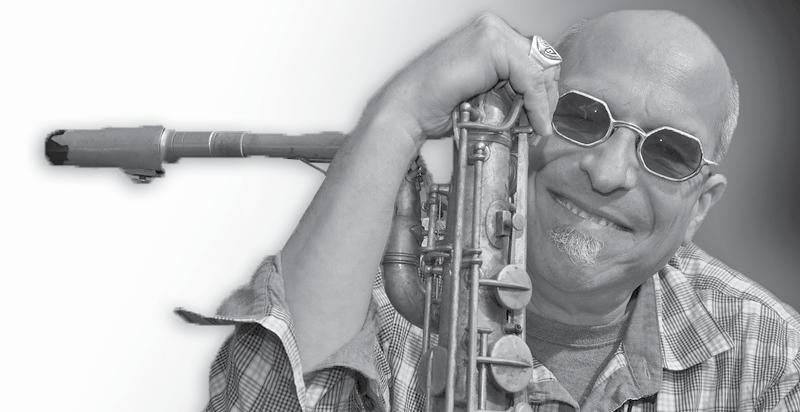
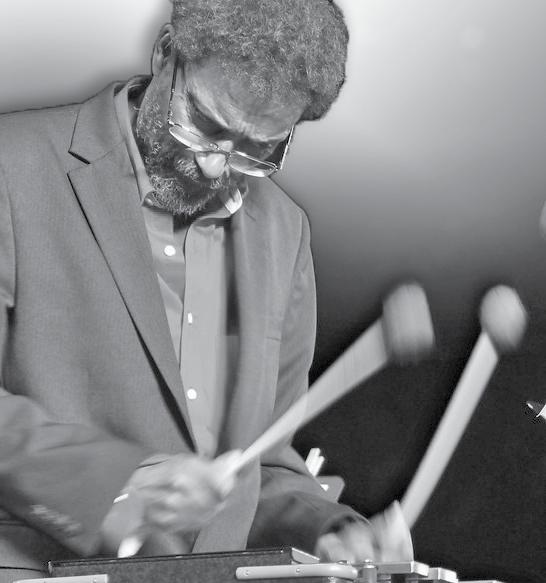
home state of Vermont and features a number of great soloists who are alumni of William Paterson’s Jazz Program.
Sunday, April 5, the Gary Smulyan/Ralph Moore Quintet will present “Encounters”, a summit meeting of world-class saxophonists. Smulyan’s award as DownBeat 2019 Readers Poll Baritone Saxophonist of the Year is the 19th such award won by this
series, with the vibraphonist Steve Nelson combining forces with the 18-piece William Paterson Jazz Orchestra led by David Demsey. Nelson is a veteran of bassist Dave Holland’s acclaimed quintet and a longtime collaborator with the late Mulgrew Miller as a member of Miller’s Wingspan group. Nelson has also performed with Kenny Barron, David “Fathead” Newman, Johnny Griffin and Jackie McLean. A bachelors and masters graduate of Rutgers University, Nelson has also been on the Princeton University faculty.
The Spring Jazz Room concerts are held at the Shea Auditorium on the WP campus, Sunday afternoons at 4 p.m., with a pre-concert “Sittin’ In” meet-the-artist session preceding each concert. Tickets are $15 for the general public; $12 for the WP community and senior citizens; and $8 for non-WP students. WP students are admitted free with ID, and there is a $3 additional charge per ticket on show day. Box office hours are Monday-Friday, 10 a.m.-5 p.m. and one hour prior to performances. Tickets may also be ordered online at wpunj.edu or by calling (973) 720-2371.

32 March / April 2020 WPU SPRING
ROOM
JAZZ
SERIES
Steve Nelson
Gary Smulyan


March / April 2020 33
Celebrate Paul Whiteman’s Birthday With Jerry Rife’s Blue Skies Quartet
By Bob Kull
Did you know that renowned jazz orchestra leader Paul Whiteman is interred in a mausoleum just about 50 yards from the front door of the 1867 Sanctuary in Ewing? Whiteman was born 130 years ago this March, and Jerry Rife’s Blue Skies Band will celebrate it in a concert of Whiteman tunes (and, weather permitting, a “Happy Birthday” near his mausoleum) at the 1867 Sanctuary on Sunday, March 29 at 2 pm.
Our complete March and April jazz schedule at the 1867 Sanctuary is:
Sunday, March 1, 2 pm:
Franklin Allison Band
Saturday, March 7, 8 pm: Guitarist Gene Bertoncini and Bassist
Josh Marcum
Saturday, March 14, 8 pm:
Jack Furlong Quartet
Sunday, March 29, 2 pm:
Jerry Rife’s Blue Skies
Wednesday, April 8, 8 pm:
Jake Eddy, Guitarist
Sunday, April 19. 2, pm
Danny Tobias and Warren Vaché
Sunday, April 26, 2 pm
Mauricio De Souza’s Bossa Brasil

The New Jersey Jazz Society is a co-sponsor of the Sanctuary jazz series. Tickets are $20 for general admission; $15 for NJJS members; $5 for school and college students. They can be ordered by logging onto www.1867sanctuary.org or reseved by calling 609-392-6409. Jazz at the 1867 Sanctuary is located at 101 Scotch Road, Ewing, NJ (One mile south of I-295 Exit 73B)
Danny Tobias with Strings
By Schaen Fox
The historic 1867 Sanctuary at Ewing has been around, not surprisingly, since 1867. The Presbyterian community acquired the place in 1712, and the Romanesque Revival structure was their fourth on site edifice. They relinquished it in 2007, and it became a “haven for arts and culture” in Central Jersey. It has wonderful musical acoustics, and offers a wide variety of talent that often includes an impressive selection of jazz artists, both famous and those well worthy of attention. In the early afternoon of January 4, trumpeter Danny Tobias brought two guitarist friends, Chris Buzzelli and Pat Mercuri, in for what he thought might be a jam session without an audience. He was wrong. One reason Tobias may have expected folks to stay away was the poor weather forecast, but as hostess Helen Kull said at the start, no matter the gloom outside, the trio would deliver, “great sunshine music in here.” That prospect had attracted a good size crowd that left Tobias “thrilled.” Of course, Tobias’ resume also helped. In addition to spending 15 years with Kenny Davern and Tony DiNicola, many great talents have invited him to share their
stages; among them: Warren Vache, Scott Robinson, Marty Grosz and Ed Metz Jr. While he holds his horn like Jon-Erik Kellso, his sound is his own, and as all there knew, it was well worth braving a storm to hear.
In all, the trio performed 15 standards, both the well-known, “In a Mellow Tone,” and “Cheek to Cheek,” and some a bit less so, “What’ll I Do?” and “Dancing on the Ceiling.” Tobias added variety to the performance by tastefully using several instruments and attachments. The most impressive was his antique E flat alto horn which had belonged to his grandfather. “He sold it to me when he was on his deathbed.” While the brass dominated, both guitarists had ample opportunity to show their chops. They easily exchanged duties of providing the rhythm, and delivering beautiful solos. Indeed, the three artists did produce the promised musical sunshine and the crowd applauded enthusiastically.
By the way, the Sanctuary’s adjacent cemetery holds the remains of dozens of Revolutionary War veterans, many of the Roebling family of Brooklyn Bridge fame, and Paul Whiteman, Tram and Bix’s old employer. I wonder if he ever gives a listen?

34 March / April 2020
JAZZ AT 1867 SANCTUARY
From left: Peter Reichlin, horns; Pat Mercuri, guitar and banjo; Danny Tobias, horns; and Jerry Rife, woodwinds. Photo by Lynn Redmile.
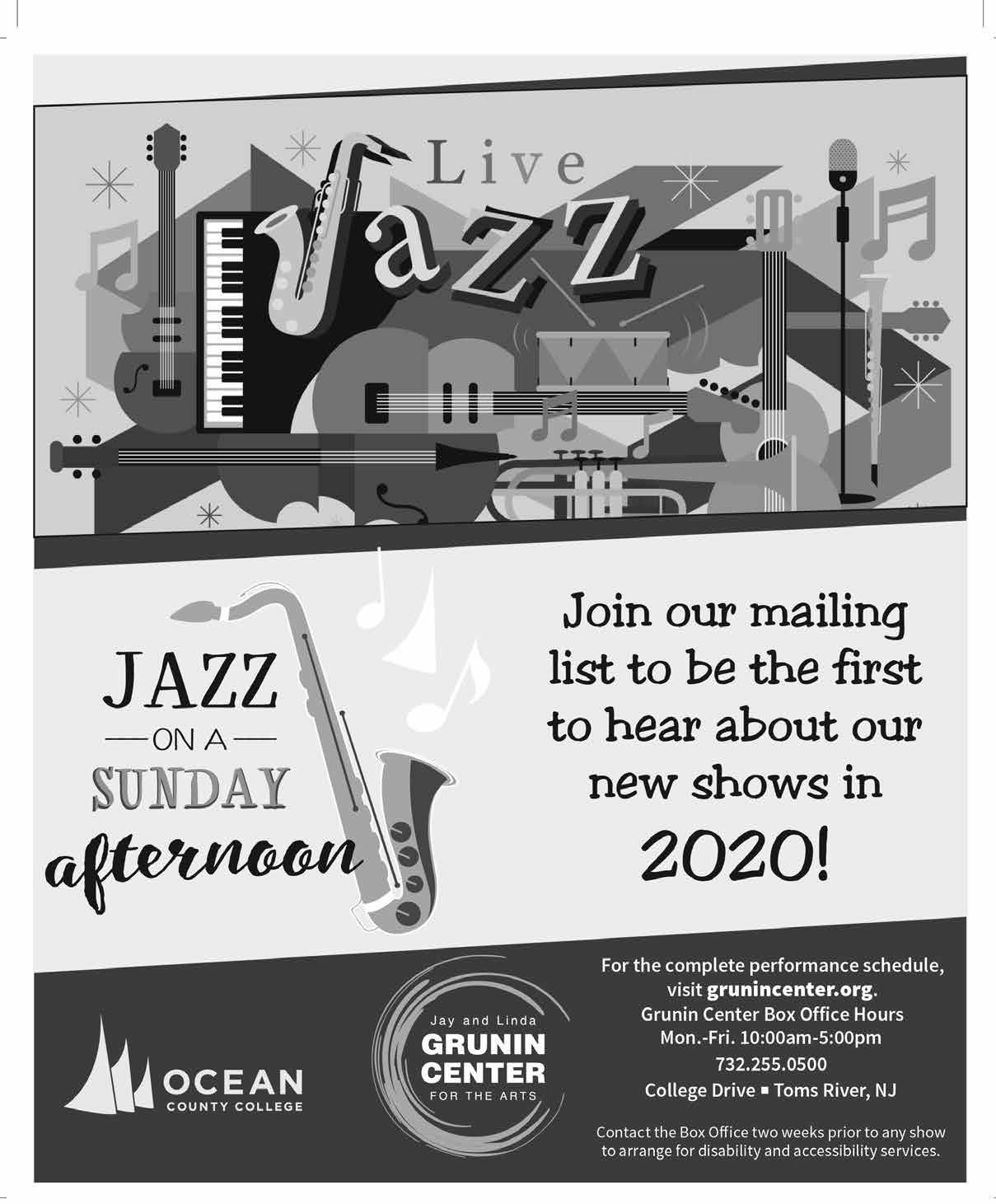

March / April 2020 35
Jazz Artist Executive Gail Boyd Elected President of Artist Management Trade Association
Gail Boyd, founding President of Gail Boyd Artist Management, has been elected as President of North American Performing Arts Managers and Agents (NAPAMA). Boyd is the first African-American woman to step into this role. She is also the first NAPAMA president to come from the jazz music industry.
Boyd’s term began on January 12, 2020, and will continue throughout the year. “I am so humbled that I was elected President of NAPAMA,” she said. “I have had a great experience working with incredible managers and agents who give their time to establish professional development and establish best practices for our community. I look forward to continuing and expanding the mission and vision of this organization.”
For more than four decades, Boyd has been a innovator in the music and entertainment industry. She has shaped the careers of countless artists as president of Gail Boyd Artist Management. Her present roster includes John Clayton, The Clayton Brothers Quintet, Brianna Thomas, Don Braden, and the Clayton-Hamilton Jazz Orchestra, among others. She has worked with a virtual who’s who of jazz luminaries in her 30-plus years in artist management including multiple Grammy Award nominees and winners, NEA Jazz Masters, and several artists that can be considered household names. In addition, she has served as the production coordinator for more than 20 CDs.
Church in Brooklyn, NY. In 2010, Danilo and Patricia Perez named Gail the International Coordinator of the Panama Jazz Festival where she served for four years.

A graduate of DePaul University, Boyd was a founding partner in Boyd, Staton and Cave, the first African-American female law firm in New York. She first became involved in entertainment law in 1976 and, in 1979, turned her attention specifically to jazz. As a lawyer, Boyd has represented jazz artists such as Betty Carter, Tommy Flanagan, and Kenny Barron. In addition to her position within NAPAMA, she is on the board of the Martin Luther King/Coretta Scott King Memorial. She is the former Vice Chair of the Entertainment, Sports, and Art Law Committee of the National Bar Association and former Chair of the Entertainment, Sports, Art Law Committee of the Metropolitan Black Bar Association. She also served as a member of the New York State Bar Association’s Committee on Entertainment Law and is a former board member of International Women in Jazz. She served as a member of the Jazz Jam Committee of the National Association of Recording, Arts & Sciences and was on the board of WBGO-FM and the Noel Pointer Foundation. For nearly 20 years, she served as Chair of Brooklyn Legal Services.
Other highlights include serving as production coordinator for Quincy Jones to produce a concert which took place in Central Park and co-producing a gospel album for the choir of Emmanuel Baptist

The rest of the recently elected Executive Committee includes Kris Kaminski of ECE Touring, Vice President; Ben Cohen, Cadenza Artists,Vice President; Tommy Hensel, Moraine Valley Community College, Treasurer; and Crandall Rogers, Four Mortals Productions, Secretary.
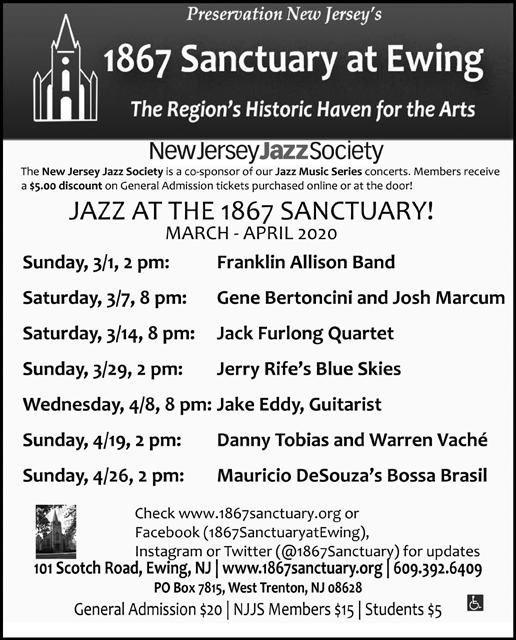

36 March / April 2020


March / April 2020 37
BIG BAND IN THE SKY
continued from page 9
much. He was an original without even trying.” Roditi finally insisted on switching from valve trombone to trumpet because he said it was interfering with his trumpet embouchure. “I never believed him,”
D’Rivera told Chinen. “I think he was just too lazy to carry around the two instruments! But I loved the way that he played any instrument.”
Roditi was best known for his blending of bebop with Brazilian music, a style exemplified in his 1994 album, Jazz Meets Samba (Groovin’ High). Ken Dryden, reviewing it for AllMusic, wrote that Roditi “takes a Brazilian-flavored look at a number of standards and familiar jazz compositions on these delightful sessions . . . The trumpeter’s tone and phrasing are at a peak throughout this disc . . .” His playing, according to Chinen, “combined a mastery of the modern jazz trumpet vocabulary -the dialects of Clifford Brown and Lee Morgan, among others -- with the essence of saudade, a distinctly Brazilian expression of melancholic longing.”
JazzTimes’ Michael West wrote about Roditi’s “fiery presence on the bandstand, having mastered the language of post-World
War II jazz trumpet . . . However, he was also capable of a preternaturally smooth tone that could take the edge off his ferocity or delve beautifully into a tender ballad . . . The warmth of his playing was matched by a warm personality. He was famously jovial and always ready with a smile and a guffaw.”
Roditi was nominated for two Grammy Awards -- for Brazilliance X4 (Resonance: 2009) and Symphonic Bossa Nova (Teldec Classics: 1994) with Ettore Stratta leading the Royal Philharmonic. He was also part of the Dizzy Gillespie United Nations Orchestra album, Live at the Royal Festival Hall (Enja Records: 1990), which won a Grammy for Best Large Ensemble Album.
Last year he was part of the Diva Jazz Orchestra’s Diva + The Boys album, recorded live at Pittsburgh’s Manchester Craftsmen’s Guild on the MCG label. He was so enthused by his participation in that project that he expressed his thoughts to Jersey Jazz writer Schaen Fox in the JanuaryFebruary issue of the magazine. “This is one of the best projects I’ve ever participated in, involving a large ensemble,” he said, adding, “I love all the songs, all the arrangements, and the playing of everybody.” Drummer Sherrie Maricle, leader of the Diva Orchestra, described Claudio to Jersey Jazz
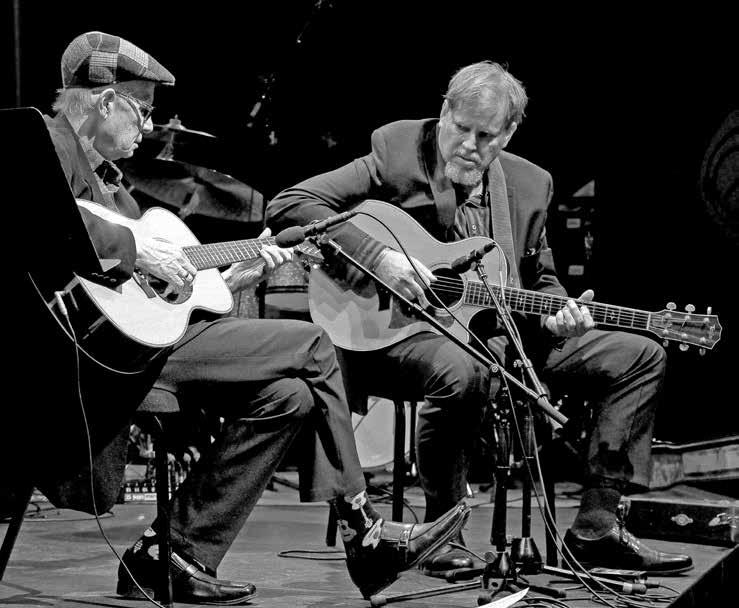
as “pure musical joy and a warm and wonderful human. His presence in the world definitely made it more beautiful, and his gifts will never leave our ears or hearts.” There are also some special stories. “My personal story,” said Dr. David Demsey, Coordinator of Jazz Studies at William Paterson University, “is watching Claudio work with the students in the Latin Jazz Ensemble during their sound check for the Jazz Room concert. That sound check is a time to, on the surface, check the sound! Some treat it as simply a tech run-through to make sure the mikes are ok. But, Claudio was able to get to a deeper level of musicality with the students, through his kindness and warmth with them. He relaxed them, got them more ready to address his music and the repertoire of the day. It was remarkable to watch and listen to him, and to sense the students’ response to him . . . amazing.”
Ohno said her best memory of Roditi was “when we were at a buffet style restaurant somewhere in the Midwest for a gig. He was almost in tears and told me how much he missed his mom’s shrimp dish. At the same time, we both were peeling tons of shrimp shells from the buffet. And, all of a sudden, somehow, I felt like I could understand why he could write such incredibly beautiful melodies.” Thanks to Schaen Fox for helping me reach out to Claudio’s musical colleagues and friends.
‘He Should Have Been More Famous’: Guitarist
Vic Juris Dies at Age 66
Vic Juris performed with his trio a few days before Christmas at the Zinc Bar in New York City. However, many New Jersey jazz fans will probably recall Juris’ duet with fellow guitarist and friend Dave Stryker of Harold Mabern’s “Edward Lee” on November 16 at the South Orange Performing Arts Center as their most recent memory of him. (See photo at left and Giants of Jazz in the January-February issue of Jersey Jazz).
Juris died on December 31, 2019, at Saint Barnabas Medical Center in Livingston, NJ, at the age of 66 after a six-month battle with liver cancer. Stryker and Juris were neighbors -- they lived on the same street in West Orange. “A musician’s musician” is how Stryker described him to WBGO’s Nate Chinen on the day of Juris’ death. “I don’t know of anybody,” added Stryker, “that

38 March / April 2020
Photo by Tony Graves
doesn’t completely give it up for Vic, considering him as one of the masters.”
The late guitarist John Abercrombie once said of Juris: “There is none better.” And, Pat Metheny, according to Chinen, said, “Vic Juris has been a total monster ever since we both hit the scene at around the same time in the ‘70s, playing great, no matter what the setting.” Guitarist Bob DeVos, another West Orange neighbor, described Juris, in a Facebook post, as “among the finest of musicians, a great teacher of many, and, most of all, a great friend.” Guitarist Charlie Apicella recalled to Jersey Jazz a private lesson he had with Juris. “I cannot believe it was only a 60-minute interaction,” he said. “I have never experienced a teacher who could describe the concepts with so few words and move so quickly from topic to topic. I will always cherish our moments playing together on stage, visiting at his concerts, our phone conversations, and the few times we hung out chatting about vintage guitars and the players we loved.”
Juris was born on September 26, 1953, in Jersey City and grew up in Parsippany. He began playing guitar at age 10 and took private lessons from guitarist/educator Ed Berg and guitarist Pat Martino. However, Stryker told Chinen, “He was pretty much self-taught. He came about his harmony, which was pretty deep, on his own. He could play the most difficult kind of music -- like the stuff [saxophonist] Dave Liebman would write, with these big, fat, stacked chords -- and figure out how to voice them on the guitar.”
Like many jazz musicians, Juris was better known among his musical peers than among the general public. He began recording with Liebman in 1991, and, during the ‘90s, also played and recorded with organist Jimmy Smith and bassist Steve LaSpina, among others. “He should have been more famous,” Liebman said to Chinen. “He played unbelievably.”
Juris recorded more than 20 albums as a leader. The last one was Two Guitars (SteepleChase Records: 2019), with bassist Jay Anderson and drummer Adam Nussbaum. Mike Joyce, reviewing the album for JazzTimes, wrote that, “It’s no shocker that Juris regards Two Guitars as one of his finest recordings . . . Certainly, fans of the late John Abercrombie and Larry Coryell will want to give a listen, as album highlights include striking Juris-penned

tributes to them.” His wife, vocalist Kate Baker, told Chinen that Juris recorded two more albums not yet released. One, due out on SteepleChase in March, will have Anderson on bass, Gary Versace on keyboards and John Riley on drums. The other will be a duets album with Baker.
In addition to performing and recording, Juris was a dedicated educator, teaching at the New School, Rutgers, and Purchase College. Baker said she believes Juris’ legacy “is how many guitarists he’s trained and mentored, from his heart. Vic would do duos with them. He would have them come to the house. He wanted to really pass down the information.”
Stryker recalled to Jersey Jazz “the hundreds of students he taught over the years at his house and in college. Several of them also stepped up when Vic got sick by coming over to play and hang. That is where his legacy will live on, from having passed his knowledge on so freely.”
One of Juris’ students at the New School was guitarist/writer David Adler, who, in a Facebook tribute, called Juris “a musical father. He was everything one could possibly aspire to be as a jazz guitarist, and he was very supportive of me . . . I’m forever grateful for his presence in my life and all the learning he so generously imparted.”
In addition to his wife, Juris is survived by a sister, Denise Martish.
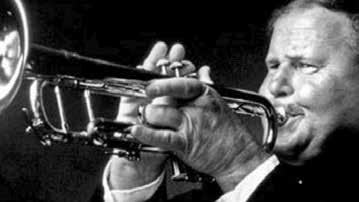
Jack Sheldon, 88, trumpeter/actor/bandleader,
In the 1950s, Sheldon was an integral part of the West Coast jazz scene. He admired and played often with fellow trumpeter Chet Baker, acknowledging that keeping company with him off the bandstand could be a risky activity. James Gavin, in his Baker biography, Deep in a Dream: The Long Night of Chet Baker (Alfred A. Knopf: 2002), related an incident when Baker, on a road
trip, siphoned gas from other cars. Sheldon, who “cowered in the back seat,” recalled to Gavin that, “Chettie was already into a little larceny then. I gave him a flugelhorn that I had checked out of [Los Angeles] City College, and he never gave it back. It was like stealing gas -- he thought it was all right to do that.” According to the Los Angeles Times’ Don Heckman (December 31, 2019), Sheldon called Baker “the James Dean of American jazz.”
Sheldon’s own playing, Heckman wrote, was spiced with “the dynamic energies of bebop amid the cooler, more laid-back orientation of the West Coast style . . . Throughout his life, Sheldon maintained his playing skills via a regimen of hard work. At 79, he still insisted that ‘my chops are good, so long as I practice every day.’” That was confirmed in a 2011 JazzTimes profile which said, “His trumpet playing is as trim and appealing as it was when he was a boon companion of such West Coast icons as Art Pepper, Chet Baker, and Gerry Mulligan.”
Heckman recalled that Sheldon “performed on a regular basis in Los Angeles clubs, usually with the small ensemble he called his California Cool Quartet, occasionally with his 18-piece big band. In November 2010, jazz critic Tony Gieske, reviewing a celebration of Sheldon’s 79th birthday, praised his ‘incomparably rich and full trumpet sound.’”
Sheldon developed an additional career as an actor and comedian. In the mid-’60s, he appeared as the co-star on The Cara Williams Show on CBS-TV. He also had his own CBS sitcom, Run, Buddy Run. He is best known to television audiences, though, for his regular appearances on The Merv Griffin Show. He was a member of the program’s Mort Lindsey Orchestra, but he often functioned as Griffin’s comedic sidekick. His visibility with Griffin also led to many music gigs. “Through him,” Sheldon told the Los Angeles Times in 1991, “I’ve got to work with every bandleader ever known: Basie, Dorsey, even Lawrence Welk. I’ve gotten to sing with Ethel Merman and do magic with Orson Welles.”
His voice is familiar from several episodes of the educational TV series, Schoolhouse Rock! His trumpet playing can be heard on several movie and TV soundtracks, most notably, on Johnny Mandel’s The Shadow of Your Smile from the soundtrack of the 1965 film, continued on page 40
March / April 2020 39
November 30, 1931, Jacksonville, FL -- December 27, 2019, Los Angeles.
BIG BAND IN THE SKY
continued from page 39
The Sandpiper, starring Elizabeth Taylor and Richard Burton. Henry Pleasants, in his book, Serious Music and All That Jazz! (Simon and Schuster: 1969), used Sheldon as an example of why movie composerarrangers liked to hire jazz musicians, “who alone know how to read the arranger’s ‘chart’.” For The Sandpiper, Pleasants pointed out, “Mandel wrote simply ‘Miles’ over a certain trumpet passage . . . meaning that he wanted his soloist to play it in the style of Miles Davis. This would have meant nothing to most symphony trumpeters; but for Jack Sheldon, who was playing it, this was all he needed to be told.”
Sheldon can also be heard on the soundtrack for the Robert Altman movie, The Long Goodbye, and on Francis Ford Coppola’s One From the Heart. He appeared as an actor on TV shows such as Dragnet and Petticoat Junction.
He is survived by his partner (and manager) Dianne Jimenez; a son, John; a daughter, Jessie; grandchildren and greatgrandchildren.
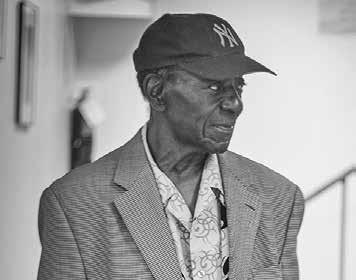
Reynolds ‘Zeke’ Mullins, 94, pianist/organist, July 11, 1925, New York -- December 4, 2019, New York.
When a friend brought Mullins to a 1965 Lionel Hampton rehearsal and audition, Mullins played Morgan Lewis’ “How High the Moon”, and Hampton reportedly said, “Pack your bags. We’re leaving tomorrow.” Mullins stayed with Hampton for 24 years.
At an early age, Mullins played classical violin and piano. Then, as a 16-year-old, he heard Hampton, Teddy Wilson, and Benny Goodman on the radio. That converted him to jazz. After leaving Hampton in 1989, Mullins played regularly during Sunday brunch at the Cajun Restaurant in New York’s Chelsea neighborhood. His band mates were tenor saxophonist/flutist Carol
Sudhalter, bassist Leonard Gaskin, drummer/vocalist Doc Pittman, and vocalist Myrna Lake.
He also became the regular pianist for the Harlem Blues and Jazz Band, retiring last year. When the Harlem Blues and Jazz Band began a regular Saturday gig in early 2017 at the Holiday Inn in Fort Lee, northjersey. com’s Jim Beckerman wrote that the band “lived the jazz history that the rest of us know from liner notes and Ken Burns documentaries.” Mullins told Beckerman: “We’re just players that were fortunate enough to be around at this time. But, after us, the music will move on to younger players.”
No information was available regarding survivors.
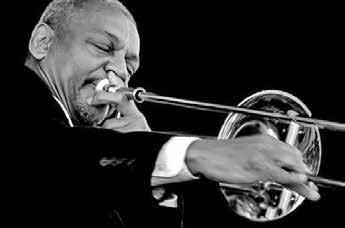
Lucien Barbarin, 63, trombonist, July 17, 1956, New Orleans -January 30, 2020, Slidell, LA.
“Every trombone player in New Orleans will say that they got something from Lucien. He was one of the giants of New Orleans music, and I’m not overstating that.” That’s how Ben Jaffe, Creative Director of the Preservation Hall Jazz Band described Barbarin to WBGO’s Nate Chinen. Trumpeter Nicholas Payton added, on Twitter, that, “A piece of the trombone just went on home.”
While Barbarin was a member of the Preservation Hall Jazz Band, he is probably best known for his association with pianist/ vocalist Harry Connick, Jr. He joined Connick’s band in 1990 and, in addition to playing trombone, was Connick’s comic partner. According to nola.com’s Keith Spera, writing on the day of Barbarin’s death, “In Rat Pack terms, Barbarin became a Sammy Davis, Jr.-style sidekick to Connick’s more comic Frank Sinatra.” When Connick’s band performed in Omaha in 2016, the Omaha World-Herald’s Kevin Coffey wrote that Barbarin was “the most exciting person onstage whenever he was featured. Barbarin went back and forth with Connick (who picked up a trumpet) on
‘How Come You Do Me Like You Do?’ The trombone master playfully led Connick along, but his skills on trombone crushed anything thrown at him.”
WBGO’s Chinen described Barbarin’s trombone style as “a full, braying sound that he could deftly turn in any direction -toward murmuring balladry or a rambunctious blare. Forged by the venerable rituals of New Orleans street parades, he was one of our era’s leading exponents of the growly tailgate style. But, he remained a modern musician, never boxed in by the traditions he served.”
Introduced to the music of Duke Ellington by a great-uncle, Barbarin made his professional debut at the age of six, playing drums with the Onward Brass Band in New Orleans. By the time he reached high school, he had switched to trombone. In 1970, he joined his second cousin, banjoist Danny Barker, in the Fairview Baptist Church Brass Band, leaving in 1974 to become part of the Hurricane Brass Band, led by trumpeter Leroy Jones. He also worked at a Bourbon Street club called The Famous Door.
In recent years, Barbarin became a regular attraction at The Palm Court on New Orleans’ Decatur Street. He was on several of Connick’s albums and recorded a few albums as a leader including It’s Good To Be Home (CDBY: 2008) and Little Becomes Much: Jazz at the Palm Court Vol. 3 (G.H.B. Records: 2000).
Shortly after Barbarin’s death, Connick posted a message on Facebook, saying, “It is with profound sadness that I share the news of the passing of Lucien Barbarin . . . Please keep his wife Sheryl, his children, and grandchildren in your prayers.”
Ricky Riccardi, Director of Research Collections at the Louis Armstrong House Museum, posted this on Facebook: “I am really broken up about the passing of the great Lucien Barbarin, one of my all-time favorite musicians. I was lucky to catch him a number of times at Satchmo Summerfest and always thought he made a terrific team with [trumpeter] Yoshio Toyama . . . Thanks for the music, the memories, and the joy.”
Cause of death was Stage IV prostate cancer. In addition to his wife, Barbarin is survived by two sons, Robert and Paul; two daughters, Alissa and Darlene; two brothers, Jerry Walker and Charles Barbarin; two sisters, Diane Abram and Angela Barbarin Foy; and seven grandchildren.

40 March / April 2020


March / April 2020 41

DAN’S DEN
By Dan Morgenstern
We lost a great one with the passing of Jimmy Heath [see “Big Band in the Sky”, page 8). There is much to say about this great musician and wonderful man who told his own story so well and so honestly in his autobiography. There isn’t much I can add In the way of an encomium, so let me tell you a story.
Quite some years ago, during my decades at the Institute of Jazz Studies, I was asked to moderate a panel starring the Heath Brothers—Percy, Jimmy and Tootie (as Albert is professionally and socially known)—at Bloomfield College. We met at the Newark train station, the threesome having arrived together, and entered the stretch limo (remember those once ubiquitous vehicles?) awaiting us and settled in comfortably. It was evident the brothers hadn’t been together for some time (musicians, needless to say, spend most of their lives on the road, and relatives are not necessarily neighbors), but they had clearly brushed up on personal matters during the train ride, as soon became evident.
What ensued instead by way of communication was unique. As brothers will, these three had much in common in the way of looks, gestures and vocal color, making them a perfect conversational trio. (They were born in 1923, 1926 and 1935, respectively). At first, we talked a bit about the panel, and then, as if on cue, the brothers began to exchange anecdotes, jokes, puns—what have you, in the whole range of comic repertory. This proceeded at a rapid pace (these guys could swing!) and this listener could hardly recover from one spell of laughter until the next trigger.
when we said goodbye, I made it known that I would never forget this day—as I obviously have not, and was able to remind Jimmy of from time to time. But every encounter with him was special.
I’m sure Joe Lang has given a proper
Philharmonic”, said Martha taught Norman “everything he knows,” a slight exaggeration, but only slight.
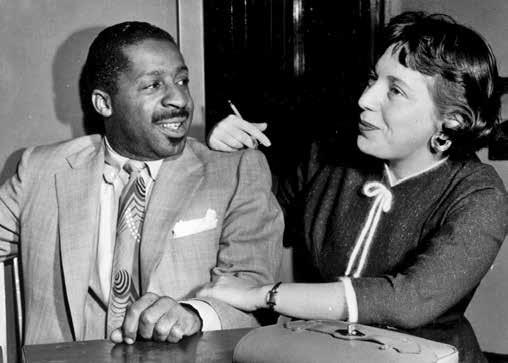
Suffice it to say that, by the time we reached our destination, I was so weak in the gut that I had trouble getting up and in serious doubt that I could carry out my moderating duties. But the brothers were kind to me, and I managed to do my introduction without breaking up. The panel came off well, the response was enthusiastic, there was some socializing with the students, and some welcome refreshments. When we settled in for our return trip, all four of us were quite ready for a bit of r and r. But
welcome to the recent spate of Erroll Garner reissues, but they’ve given me such special pleasure that I can’t resist chiming in. The sound restoration is remarkable, thanks to the preservation of the original sound sources, and that preservation, along with almost everything related to the immortal pianist’s career, is due to the forethought of Garner’s devoted personal manager, Martha Glaser, who placed it in the good hands of her niece Susan Rosenberg. Martha, not related to Joe of Armstrong fame, took Erroll in hand at a time when his talent was exposed to the vagaries of the music business and made him the highest paid jazz concert artist of all, not to mention other career building. She was a very special lady who, had she wanted to, could have shared her deep knowledge of that so-called business (most recently in the news via the Grammy scandal). Trummy Young, the great trombonist who was one of the first members of Norman Granz’s “Jazz at the
I had the pleasure of getting to know Martha well—well enough for her to call me well after hours (she was an insomniac)—which I never minded as she always had great stories to tell and wisdom to share. In any case, the Garner treasures now restored never sounded so good and serve as an unfortunately needed reminder of just how great an artist he was. Only Louis Armstrong could communicate with an audience—any audience— like Garner, from first note to last. Or leave that audience, concert hall or nightclub, in a state of exultation. Some arbiters of taste claim that deep music should engender knitted brows, but Garner knew better. Listening to him in depth once again proves that Martha was right when she named one of his albums “The Most Happy Piano.” Happiness is hard to come by these days, so listen!

42 March / April 2020
questions on page 31 1. Eddie Lang 2. Django Reinhardt 3. Charlie Christian 4. Wes Montgomery 5. Tal Farlow 6. Charlie Byrd 7. Les Paul
JAZZ TRIVIA ANSWERS
Erroll Garner and Martha Glaser. Photo: University of Pittsburgh Library


March / April 2020 43
Ronnie Scott’s
1959-69:
Photographs by Freddy Warren
Reel Arts Press, London
144 pages, 2019, $39.95
By Joe Lang
Ronnie Scott’s Jazz Club is one of the world’s most legendary and iconic jazz venues. It was founded on 1959 by two saxophonists, Ronnie Scott and Pete King, who were on the cutting edge of the then current jazz scene in London. A brief essay by Graham Marsh in Ronnie Scott’s 1959-69, a book that primarily consists of photographs of musicians by Freddy Warren, tells the story of the founding and subsequent life of the club.
In the period covered by the photographs in this book, many of the major jazz stars from the United States, as well as the cream of the crop of the British jazz players appeared at the club, both in its original location and at the venue to which it relocated in 1968.
Initially, the players were all British, as the union rules made it difficult to get permission for American players to perform in Great Britain. Those who did were able to do so as a result of exchange agreements, with British players going to perform in the United States and their American counterparts playing in Great Britain. The first American jazz musician to play the club
was Zoot Sims who played his initial gig there in 1961. As the years went on, American jazzmen appeared at Scott’s with increasing frequency.
A photographer named Freddy Warren became a fixture at the club, becoming fast friends with Scott. He documented in photos the musicians who played at Ronnie Scott’s. Warren died in a fire at his apartment in 2010, but his nephew, Simon Rattle, was able to salvage thousands of negatives that Warren had accumulated. An interview of Rattle conducted by Mark Baxter, producer of a documentary of the great British saxophonist Tubby Hayes, gives the story of Warren and his involvement with Ronnie Scott’s as well as some information about his uncle’s life as a photographer in other areas.
The photographs selected for inclusion in this volume show the musicians in both performances, as well as in more casual settings. The action photos capture the intensity of the musicians during their moments of creativity. Almost all of the major American players of note from the decade covered are present. Cannonball Adderley, Count Basie, Tony Bennett, Art Blakey, Al Cohn, Miles Davis, Duke Ellington, Bill Evans, Ella Fitzgerald, Stan Getz, Dizzy Gillespie, Roland Kirk, Thelonious Monk, Wes Montgomery, Buddy Rich, Max Roach, Sonny Rollins, Wayne Shorter, Zoot Sims, Jimmy Smith, Sonny Stitt, Mel Tormé, Ben Webster, and Trummy Young are among those depicted. The British players pictured who should be familiar to those on these shores include Victor Feldman, Tubby Hayes, Pete King,
Spirit to Spirit: A Portrait of Pittsburgh Jazz in the New Century
By Abby Mendelson
MCG Jazz, Pittsburgh
298 pages, 2019, $39.95
Pittsburgh has a storied jazz history with players and vocalists such as George Benson, Art Blakey, Billy Strayhorn, Billy Eckstine, Ray Brown, Bob Cooper, Dodo Marmarosa, Erroll Garner, Maxine Sullivan, Mary Lou Williams, Earl Hines, Ahmad Jamal, and Harold Betters having been born there. A host of players carry on that tradition today on the Pittsburgh scene. Spirit to Spirit provides profiles of 50 individuals and groups who are keeping the jazz tradition vibrant in Pittsburgh, with the sprightly text by Abby Mendelson augmented by superb photographs by David Aschkenas. Most of the individuals highlighted will be unfamiliar to listeners outside of the Pittsburgh area, but there are players like Richie Cole,

Cleo Laine, Dick Morrissey, Annie Ross, Stan Tracey, and, of course, Ronnie Scott.
This visual picture of the first decade of Ronnie Scott’s Jazz Club gives a welcome perspective to those jazz enthusiasts who have heard much about this heralded jazz venue, but were never present to witness the goings on during that period. For those lucky enough to have experienced it in person, it shall bring back memories galore.
Thanks go to Simon Rattle for his dedication to the work of his beloved uncle, and to those at Reel Arts Press who did an excellent job of editing and presenting these wonderful photographs.
(Note: For more information about Freddy Warren and his photographs, visit the website that Simon Rattle has developed for this purpose, arttozoot.com.)
Sean Jones, Roger Humphries, Joe Negri, Frank Cunimondo, Benny Benack III, Dwayne Dolphin and Paul Cosentino who should register with a broader audience.
What this book will do is encourage the reader to dig a bit to hear some of the players who are new to them, but whose profiles spark their interest. Anyone who has traveled a bit and sought the sounds of jazz in a new place has experienced some eye and ear opening moments when checking out the local scene. Those moments are more available in Pittsburgh than in most places.
This is a beautifully produced volume, designed by David Wachter, one that suits the designation “coffee table book,” but it serves as more than mere decoration. The book is informative, and a fine tribute to the players who are profiled.
Spirit to Spirit exemplifies the wonderful work that Marty Ashby and his associates at MCG Jazz have done in preserving, promoting and keeping alive the important contributions to jazz that have been characteristic of Pittsburgh and its musicians through the concerts at the Manchester Craftsmen’s Guild, the MCG Jazz recordings, and a variety of educational endeavors. (mcgjazz.org)

44 March / April 2020 BOOK REVIEWS

OTHER VIEWS
By Joe Lang
The new albums keep coming, I keep listening, and here are the best of what I have heard.
All enthusiasts of the music of Stan Kenton have been thankful to Bill Lichtenauer’s Tantara label for keeping the Kenton legacy alive and vibrant. Concert Impressions (Tantara – 1134) is a two-disc set that features live performances from three iterations of the 1970s STAN KENTON ORCHESTRA on one disc, and charts of Kenton material re-conceived by Bobby Lamb for the English TRINITY COLLEGE
BIG BAND AND SYMPHONY
ORCHESTRA. The 2 1/2 hours of music is full of excitement, and, like much of Kenton’s music, offers the listener many challenges. Kenton was never one to stand still, always looking for new ways to expand the horizons of his orchestra. The music of his 1970s period was particularly unique, sometimes dealing with unusual time signatures and atonal charts. Lamb’s arrangements give familiar Kenton material like “Malaguena,” “The Peanut Vendor” and “Artistry in Rhythm” new looks that would likely have met with Kenton’s approval. There is a lot of music packed onto these discs, music that is full of energy and creativity that demands your full attention. (tantaraproductions.com)
DUKE ELLINGTON AND HIS
ORCHESTRA could be a bit spotty in live performance, but when they were on, it was magic. Uppsala 1971 (Storyville – 1018482) was one of those times. Uppsala is a town in Sweden, a country for which Ellington had a special affinity. The program runs almost 80 minutes, and includes many selections that are less familiar to all but the most devoted Ellington enthusiasts, tunes like “Chinoiserie,” “Fife,” “Happy Reunion” and “One More Time for the People.”
There are two long tracks, “A Tone Parallel to Harlem,” the extended piece in which Ellington captured the sounds and feeling of Harlem, and a 19-minute medley of 13 of his most famous songs. There is a stunningly beautiful closer with Ellington at the piano playing “Lotus Blossom,” accompanied only by bassist Joe Benjamin. Ellington’s spoken introductions to the selections are typical of his winning blend of humor and elegance. This is a worthy addition to the extensive catalog of available

Ellington material. (storyvillerecords.com)
Not long after his arrival in the United States from his native Russia, trumpeter Valery Ponomarev found himself a member of Art Blakey’s Jazz Messengers from 1976 to 1980. The Blakey influence has always been an important part of Ponomarev’s career. For several years he has been leading the VALERY PONOMAREV BIG BAND.
Our Father Who Art Blakey: The Centennial (Summit – 758) is the second album by the band, this one recorded live at Dizzy’s Club Coca Cola. The eight selections, arranged by Ponomarev, are pieces that were in the Blakey book. They are all jazz tunes written by giants like Wayne Shorter (“Tell It Like It Is,” “One By One” and “Hammerhead”), Benny Golson (“Are You Real” and “Kalypso”), Juan Tizol (“Caravan”), Bud Powell (“Webb City”) and Horace Silver (“Quicksilver”). Shorter, Golson, and Silver were members of the Jazz Messengers at various times. Ponomarev’s charts are swinging and fun to hear. The players sound like they are having as much fun as the listeners. This 2019 recording is a fitting tribute to Blakey on the occasion of his centennial celebration. (www. summitrecords.com)
THE UNIVERSITY OF TORONTO JAZZ ORCHESTRA shows to fine advantage on its new album, Embargo (Self-Produced). The 19-piece aggregation is filled with scintillating soloists, and plays the charts with precision and verve. With the exception of the Rob McConnell chart on “Take the ‘A’ Train,” all of the songs were arranged by members of the orchestra, who also wrote the compositions, other than the Randy Weston’s classic, “Hi Fly.” The one outlier is a selection titled “Undiagnosed” that would better have been titled ‘Unfocused.” Overall, the album is a delight, and is another example of the wonderful jazz currently being produced in many colleges and universities. (www. amazon.com - mp3 only)
The Music of Wayne Shorter (Blue Engine -0023) finds the JAZZ AT LINCOLN CENTER ORCHESTRA exploring 10 compositions by Wayne Shorter, the tenor/
soprano saxophonist who is recognized as one of the most outstanding jazz composers on the scene. Shorter, who first came to prominence in the late 1950s as a member of Art Blakey’s Jazz Messengers, was also a member of the 1960s Miles Davis Quintet, co-founded the influential fusion group Weather Report in 1971, led fusion-oriented groups on and off for the next few decades, and returned to leading acoustic groups in the early 2000s. His compositions have been covered by many other jazz players. On this two-disc set, various members of the JALCO have arranged Shorter’s tunes, and Shorter performs as a guest soloist on several selections. The charts are mostly in the mainstream swing tradition of the JALCO, emphasizing the melodic strength of Shorter’s compositions. The arrangements are crisp, and the band is in top form, with the usual sparkling solo interludes from this company of superb individual talents. JALCO once again proves to be one of the outstanding existing big bands. (blueenginerecords.org)
Bassist TOMMY CECIL has a wonderful facility for playing in a duo format. On American Melodies (Blue Line 1119) guitarist NATE NAJAR joins Cecil for a 13-song program that is an inspired selection of terrific tunes that are far from overdone. Aside from “Of Thee I Sing,” “Glad to Be Unhappy” and “Rosalie,” their choices are surprising, but welcome. The inclusion of Stephen Sondheim’s “A Little Priest” from Sweeney Todd might be the most unexpected, but Cecil did two spectacular duo albums of Sondheim music with pianist Bill Mays, so perhaps that influence carried on here. Other selections include jazz tunes such as Tommy Flanagan’s “Minor Mishap,” “Bitty Ditty” by Thad Jones, Benny Golson’s “Out of the Past” and “Black Beauty” by Duke Ellington. Lesser known titles by great composers of the Great American Songbook included Harold Arlen’s “Like a Straw in the Wind” and Hoagy Carmichael’s “Winter Moon” as did Billy Joel’s “The Longest Time,” and a couple of pieces from the classical world,
continued on page 46
March / April 2020 45
OTHER VIEWS
continued from page 45
Ned Rorem’s “Romance Without Words” and “Samuel Barber’s “Sure on This Shining Night.” These gentlemen cover a wide spectrum, and bring delightful freshness to each piece. They consistently display the musical empathy that is essential to effective duo playing. By the time you get through listening to this program once, you will be amazed at how quickly the time has passed and will feel a compulsion to immediately revisit what you have just experienced. (www.bluelinemusicrecords.com)
Go to the LA area, and ask local jazz enthusiasts which trumpet players stand out, and you can be assured that CARL SAUNDERS would be a name found on every list. He is known for his crisp, bopbased trumpet wizardry and is also a superb lead player, capable of playing up tempo numbers with fire, and caressing ballads with impressive sensitivity. He also happens to be a terrific composer of highly listenable tunes, often filled with the sense of humor that is part of his performing personae. His wit is reflected in the titles of many of his compositions, names like “Not a Sonata in Bb,” “Waking Up Is Hard to Do,” “Symphony Blues,” “Minor Infraction,” “A Poor Man’s Mr. Evans” and “Hipnicity.” All of these songs are among the 49 selections found on four albums of songs composed by Saunders, New Jazz Standards (Summit -630) by the late reedman SAM MOST, released in 2014; New Jazz Standards (Volume 2) (Summit – 683) by trombonist SCOTT WHITFIELD, released in 2016; New Jazz Standards (Volume 3) (Summit – 716) by pianist ROGER KELLAWAY, released in 2018; and New Jazz Standards (Volume 4) (Summit – 740) by guitarist Larry Koonse, released in 2019. All of the players on the albums are among the cream of mostly Los Angeles-based players such as pianists Christian Jacob and Josh Nelson; bassists Kevin Axt, Jay Leonhart, the only New York cat, and Tom Warrington; and drummers Santo Savino, Peter Erskine and Joe LaBarbera. They give wonderful life to the Saunders tunes, with only two of them appearing on two albums. Each album has a flavor of its own, but the consistency of the quality that Saunders exhibits in his writing is impressive and ear opening. This series is a refreshing look into the creative artistry of Carl Saunders, certainly one of the best tunesmiths on the scene today. (www.summitrecords.com)
Pianist EMMET COHEN has been
recording a series titled the Master Legacy Series featuring some of the living legends of jazz. The first two with drummer Jimmy Cobb and bassist Ron Carter were released on the Cellar Live label. There are two new additions now available Master Legacy Series Volume 3 – Emmet Cohen featuring Benny Golson & Albert “Tootie” Heath (Self-Produced) and Master Legacy Series
Volume 4 – Emmet Cohen featuring George Coleman (Self-Produced).
The first of these new recordings has Cohen on piano, Golson on tenor sax and Heath on drums with either Russell Hall or Corcoran Holt on bass. They play a program of nine selections mixing jazz tunes such as Tadd Dameron’s “Lady Bird,” Herbie Hancock’s “Promise of the Sun,” Dizzy Gillespie’s “Woody ‘n You,” John Coltrane’s “Straight Street,” Heath’s “For Heaven’s Sake” and James P. Johnson’s “Charleston” with standards that include “It Don’t Mean a Thing (If It Ain’t Got That Swing),” “Embraceable You” and “Just You, Just Me.” Interspersed with the music are some oral reminiscences by Golson and Heath. Golson has lost none of his fluidity despite being almost 90 years of age when these recordings were made. Heath, who was in his early 80s still had an unrelenting swing and continued to be among the most musical of drummers. Cohen has learned his lessons well and plays with a maturity that has set him among the upper echelon of current jazz pianists. This collection is straight ahead jazz at its best. (www. emmetcohen.com)
For the set with Coleman, Cohn has enlisted Russell Hall on bass and Bryan Carter on drums. Their selections include two Monk tunes, “Trinkle Trinkle” and “Ugly Beauty,” “For Big G,” written by Cohen, “I Surrender Dear,” “Don’t Blame Me,” “On Green Dolphin Street,” “Triste,” “You’ve Changed” and an improvised “Db Blues.” Coleman is a harder-edged player than Golson, one who has developed a distinctive sound and approach that reflects many influences from Charlie Parker to John Coltrane. He and Cohen’s trio fit together seamlessly, sounding as if they had been playing together for quite some time rather than the reality that this session was their first venture together. The music is always engaging and provides a nice contrast to the sessions with Golson and Heath. (www. emmetcohen.com)
Tenor saxophonists JEFF RUPERT and GEORGE GARZONE have hooked up with pianist Richard Drexler, bassist Jeremy Allen
and drummer Marty Morell for a dynamic new album, The Ripple (Rupe Media –13020). According to Rupert’s liner notes, the title alludes to the influence that Lester Young has had on jazz players who followed him. The overt Young influence is more apparent in the playing of Rupert than Garzone, who has a somewhat harder edge to his sound. They fit nicely into the tradition of two tenor teams, assaying a dozen tunes, five standards, three Rupert originals and four jazz tunes. Both Rupert and Garzone are interesting and creative soloists. The rhythm section is superbly supportive, with Drexler supplying satisfying solo interludes. Tenor sax fans should put The Ripple on their wish list. (store.cdbaby.com)
You Can’t Lose With the Blues (Savant -2178) finds pianist LAFAYETTE HARRIS JR. leading a trio that also includes bassist Peter Washington and drummer Lewis Nash through a dozen selections that cover a lot of styles., but Harris brings a touch of the Blues to each of them. He wrote three of the tunes, the title song, “Blues for Barry Harris” and “The Juicy Blues.” There are some standards, “He’s My Guy,” “Ev’ry Time We Say Goodbye” and “Wonder Why;” several pop tunes such as “Don’t Let the Sun Catch You Crying” and “Please Send Me Someone to Love”; and a few jazz classics, Charlie Parker’s “Bloomdido” and Mercer Elington’s “Things Ain’t What They Used to Be.” From start to finish, this album is filled with excitement, played by three cats who are on the same wavelength. Harris is not as widely known as many of today’s pianists, but he should be! (www. jazzdepot.com)
Winter Days at Schloss Elmau (ACT-9105) by ECHOES OF SWING with REBECCA KILGORE could have been included in my column of Christmas releases, but it did not arrive on time for inclusion, and it is not strictly a Christmas album, rather an album about winter with some Christmas themed selections. Regardless of the timing, it is a sophisticated collection that includes some familiar material, “I’ve Got My Love to Keep Me Warm,” and “Winter Wonderland;” some lesser known songs by familiar songwriters, “Winter Moon” by Hoagy Carmichael and Harold Adamson, “The Bell That Couldn’t Jingle” by Burt Bacharach and Larry Kusik,“Snowbound” by Dave Frishberg, “Snow” by Irving Berlin and “Looks Like December” by Antonio Carlos Jobim and Francisco Baraque De
continued on page 48

46 March / April 2020


March / April 2020 47
OTHER VIEWS
continued from page 46
Hollanda; some poetry set to music by pianist Bernd Lhotzky, “Stopping By Woods on a Snowy Evening” by Robert Frost, “Sonnet 97” by William Shakespeare” and “The Night Is Darkening Around Me” by Emily Brontë; and three original lyrics by Kilgore, “It’s Getting to Be That Time of Year,” with her own music, “Winter Day,” with music by Lhotzky and “The Three Wise Men,” with music by alto saxophonist Chris Hopkins. Echoes of Swing includes, Hopkins, Lhotzky, trumpeter/flugelhornist Colin T. Dawson and drummer Oliver Mews. In addition to Kilgore, Henning Gailing appears on bass, and Rolf Marx adds his guitar on four tracks. This is an album that is mostly reflective, best enjoyed with careful listening. Kilgore is, as ever, a special vocalist. Echoes of Swing has consistently shown itself to be a group that is immediately welcoming to its listeners. The combination of material, vocalist and musicians on Winter Days at Schloss Elmau is irresistible. (www.actmusic.com)
If you have seen Danish vocalist SINNE EEG in person, you know that she is one fine singer, and an impressive presence. On We’ve Just Begun (BFM Jazz – 7621834675)
THE DANISH RADIO BIG BAND backs her for a 10-song program that is eclectic, and consistently engaging. Yes, she does a few standards, “My Favorite Things,” “Detour Ahead” and “Comes Love.” There is even a Danish number from a 1937 film. Five of the tunes have lyrics and or music by Eeg. The title track is a joint effort with the creative Los Angeles singer/songwriter Mark Winkler, and gets the album off to a kicking good start. It never lets up. Eeg is a distinctive stylist who effectively includes scat choruses that are well conceived and executed. The band provides the kind of support that singers crave and appreciate. The arrangements for “Detour Ahead” and “Comes Love” were provided by the late, great Roger Neumann, the tenor saxophonist/arranger who was instrumental in getting Eeg some of her initial exposure in this country. Eeg is an impressive vocalist, and this album shows her off to wonderful effect. (bfmjazz.com)
Dallas-based vocalist CAROLYN LEE JONES is one of those singers who deserves to reach a wider audience, and her latest release, Close Your Eyes (Catn’round Sound), should help to earn her just that. The 12 tracks find her in various instrumental settings from a trio to an octet.
She brings a nice freshness to even the most familiar selections like “Close Your Eyes,’ “No Moon At All,” “The Nearness of You,” “That Old Black Magic,” “Can’t Take My Eyes Off of You” and “I Only Have Eyes for You.” Then she finds a few mostly overlooked gems such as “I Was a Fool,” “Love After Midnight,” “When I Found You” and “All Night Long.” It is always fun to hear the whimsical Dietz and Schwartz song from The Bandwagon, “Confession.” Jones is comfortable at any tempo, and is attentive to each lyric that she sings. In a market flooded with new vocal releases, it is nice to find one that stands out like Close Your Eyes. (www.carolynleejones.com)
When you see an album with Sue Raney adding her voice to a duet, as she does on the title track from Pure Imagination (Amber Inn Productions) by AMBER WEEKES, it makes you think that there must be something special happening. As you proceed through a tasty selection of songs like “It’s All Right With Me,” “Gotta Be This or That,” “After You’ve Gone” and “Just Squeeze Me,” you find that this is a lady who knows how to sing. Add in a trio of songs by Oscar Brown, Jr., “The Snake,” “Brown Baby” and “Mister Kicks,” and you can be sure that she can handle the hippest of material. She can also give two distinctly different readings of the Johnny Mercer/ Barry Manilow jewel, “When October Goes,” one slightly up, and the other a straight ballad interpretation, and make both of them work equally well. Amber Weekes is a lady with Pure Imagination that comes through clearly on this outing. (amberweekes.com)
Bardfly (Portuguese Knees Music) by vocalist/songwriter JOHN ALLEE is simply one of the most delightfully hip albums to recently come across my desk. Allee has combined his love for the words of William Shakespeare and the music of jazz to create an imaginary world where these two passions come together. With the help of a strong quintet of pianist Mahesh Balasooriya, drummer Aaron McLendon, bassist Dominic Thiroux, saxophonist Javier Vergara and trumpeter Matt Von Roderick he has set 13 pieces by Shakespeare to music, while adding some lyrics of his own here and there. This is a collection that is easier to listen to than to describe. It simply grabs your attention right away, and you find yourself enjoying a journey of words and music that is transfixing. The more you listen to Bardfly. the more you find to enjoy.
It is different, but in a delightful way. (johnallee.com)
The Musical Theater Project in conjunction with Harbinger Records has been making available much rare material from the world of Broadway musical theater, much to the delight of fans of this genre. Their latest entry is I Love My Wife: Backers’ Audition (Harbinger 3601). With narration by lyricist/librettist Michael Stewart, composer/ pianist Cy Coleman, Stewart and vocalists Laurie Beechman and Austin Pendleton run through the score from I Love My Wife. It gives fascinating insight to what transpires when the creators of a new show present their work to potential investors. I Love My Wife became a hit that ran for two years on Broadway, with the title song having recordings by the Frank Sinatra, Bill Evans and Mark Murphy, among others. In addition to the songs from I Love My Wife, Harbinger has included songs from two other musicals that Coleman was working on at the same time, neither of which reached Broadway. There are two demos from Atlantic City, lyrics by Christopher Gore, and three from Home Again, lyrics by Barbara Fried. If you are into a deep dive into the world of Broadway musicals, this is a good opportunity to enjoy some material that should fascinate and interest you.
(www.harbingerrecords.com)
For additional Other Views, log onto njjs.org after March 1.
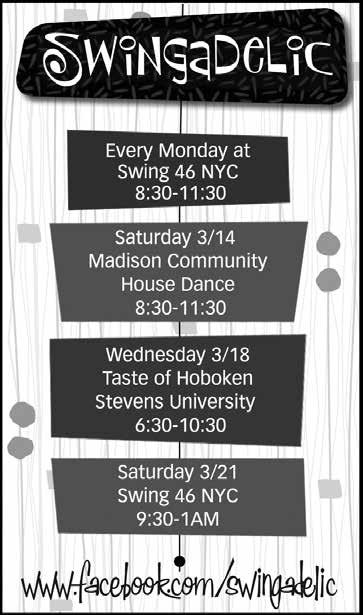

48 March / April 2020

NOT WITHOUT YOU! We can’t do what we do without you!
Your membership is vital to NJJS’s mission to promote and preserve America’s great art form – jazz! Thank you and welcome to all who have recently joined or renewed their memberships.
* Three – year Membership † Gift Membership
Names in bold type - Patron Membership
RENEWED MEMBERS
Inge Baird Wayne, NJ
Joan Bauer Bethlehem, PA
Anne Bergquist Morris Plains, NJ
Edward Berlly Pinebrook, NJ
Phyllis Blanford Newark, NJ
Kevin Bleach New Providence, NJ
Robert Boardman Mahwah, NJ
C Graham Burton Ridgefield, CT
Kevin Cannon & Kathi Cobb Clark, NJ
Claus Cardinal Watchung, NJ
David Colby Princeton, NJ *
Anne Cottavaz & Prit Bhamral Secaucus, NJ
Rick Crane Verona, NJ
Anthony DeCicco Lincroft, NJ
Tobia Del Giudice Monroe Township, NJ
David Dilzell Westfield, NJ
Jay Dougherty Maplewood, NJ
Ebsco Industries NY Public Library
Ebsco Industries
Jersey City Library
Sanford Feld West Orange, NJ
Priyan Fernando Chatham, NJ *
Chuck Folds NYC, NY
Herb Gardner Norwood, MA
Anthony Gartmond Lawrenceville, NJ
Bruce Gast Watchung, NJ *
Jerry Gordon Troy, NY
Richard C Griggs Westfield, NJ
Harriet Grose Morristown, NJ
Carol Hemington Edison, NJ
Edythe Hittcon Iselin, NJ
Howard Holtz Maplewood, NJ
Carrie Jackson Irvington, NJ
Daniel Kassell NYC,NY
Severn P Ker Brookpark, OH
Robert Kirchgessner Jr. Rockaway, NJ
Robert Kurz Livingston, NJ
Paige L’Hommedieu Convent Station, NJ *
Jeremy Johnson Newark, NJ
Larry Johnson Orange, NJ
Ed Loeb, TLC Logistics Montclair, NJ
Stephen Lilley Branchburg, NJ
Arthur Matthews, Summit, NJ
Francis McCann Somerset, NJ
Jack May Montclair, NJ
John Mintz Rockaway, NJ
Daniel Muccia Cornwall, NY
M Kevin O’Connor Verona, NJ
Gerard Orleman Brick, NJ
Ronald & Joanne Pelletier Fishkill, NY
James Penders, Madison, NJ
Lawrence Peterson Wyckoff, NJ
Pasquale & Mary, Pratico Trenton, NJ
Stacy & Barbara Roth Fairless Hils, PA
Frederick Salmon Sparta, NJ
Ira Schlitt Metuchen, NJ
Robert Seeley Flemington, NJ
Martha Seidler Newfoundland, NJ
Bud Smith Boynton Beach, FL
Roland Smith Bethlehem, PA
Anthony Speranza Garwood, NJ *
Dr. Bruce Stern West Orange, NJ
Robert Stevenson Mahwah, NJ
Howard Tavin Fort Lee, NJ
Tom Toronto Leonia, NJ
John Tumpak Reseda, CA
David Voorhees Hopewell, NJ
June Willson Essex, CT
Jim Yanda Maplewood, NJ New Members
Bell & Shivas Rockaway, NJ Corporate
Joseph Bell Rockaway, NJ *
Ed Berryman Madison, NJ *
Kevin Bleach New Providence, NJ
Jen Breitenstein Madison, NJ
Steven Brot West Orange, NJ
Noal Cohen Montclair, NJ
Douglas Cooke
East Orange, NJ
Loren Daniels Teaneck, NJ
Toni Densor West Orange, NJ
Larry & Roz Goodman
Franklin Lakes, NJ
Denis Gunasekara
Hillsborough, NJ
Michael Grabas
Cedar Grove, NJ
Philip Grauman East Orange, NJ
Art Heyl Green Village, NJ
A.J. Lechner Westfield, NJ
Cheryl Levy
BaskingRidge, NJ *
Kevin P McGee Metuchen, NJ
Susie Meissner Lawrenceville, NJ
A.A Minars Montclair, NJ
Flip Peters Teaneck, NJ
Barbara Sabella North Arlington, NJ
Joan & Tony Scalera Rockaway, NJ *
Linda Schenker Ridgewood, NJ
Elizabeth Tomboulian Ridgewood, NY *

March / April 2020 49
CAUGHT IN THE ACT
By Joe Lang
92nd Street Y
Lyrics & Lyricists:
Yip Harburg
New York, January 25-27
and they provided the music for most of the selections covered on this occasion. The exceptions were “Brother, Can You Spare a Dime,” his first major success written with Jay Gorney, and “Free and Equal Blues,” a highly charged political song written with Earl Robinson. These two songs were prime examples of the influence of Harburg’s political activism on his writing.
His most successful Broadway show was Finian’s Rainbow, a fantasy musical written with Lane that had strong political themes.
than the six-piece group that it was. The five singers brought the Harburg lyrics to life with excellent voices, and convincing interpretive abilities. Harburg was well served by this tribute to his much admired life and work.
Steve Ross:Cole Porter –Songs of List and Lust
January 23

Lyricist E.Y. “Yip” Harburg was considered among the most clever and literate lyricists among the creators of the Great American Songbook. He was also remembered for his social consciousness, a committed man of the left who incorporated his personal beliefs into his lyrics.
Both aspects of Harburg were on full display at the opening program of the 2020 Lyrics & Lyricists series at the 92nd Street Y. Unlike most of the prior programs in this series, the Harburg concert did not have a host/ narrator. Rather, the singers, Mikaela Bennett, Laura Darrell, Clifton Duncan, Megan Sikora and Nick Spangler, provided the connective commentary for the evening.
Harburg worked with many composers during his career, but Harold Arlen and Burton Lane were his primary collaborators,
From this show, the songs “That Great Come-and-Get-It Day,” “How Are Things in Glocca Morra,” “If This Isn’t Love” and “Look to the Rainbow” were included in the program.
Steve Ross is certainly among the best interpreters of the songs of Cole Porter, bringing out the sophistication, wit, and sensitive emotions that Porter, a peerless wordsmith, expressed in his lyrics,
For this delightful one-hour visit into Porter’s world, Ross had assistance from vocalist Karen Murphy. The emphasis was on the genius that Porter had for creating memorable “list” songs, songs that strung together series of words, phrases or concepts that built upon a given theme or topic. Probably the best known of these creations were the ones with which Ross chose to open and close the program, “You’re the Top” and “Let’s Do It.”
Other familiar songs performed were “Down With Love,” “You’re a Builder Upper,” “Happiness Is a Thing Called Joe,” “It’s Only a Paper Moon,” “Let’s Take a Walk Around the Block” and “Lydia, The Tattooed Lady,”
Of course, Harburg’s lyrics for the score for The Wizard of Oz are the highlight of his career, and the first act closed with a medley of songs from this source, including his most endearing lyric for “Over the Rainbow.”
The production was well conceived, with the script by Jon Marans capturing the many elements that were “Yip” Harburg. Director Matt Kunkel provided a flow to the evening that kept things lively. The instrumental ensemble led and orchestrated by pianist Paul Masse sounded much larger
Many of Porter’s songs were suggestive. He dealt with the subject of romantic relationships in ways that others avoided. Ross and Murphy chose to include what is perhaps his most risqué lyric, “But in the Morning, No,” a list song with eight choruses, each one full of double entendres about various activities. In the case of “The Physician,” Porter found ways to make what is essentially a listing of various organs and body parts sound salacious, and Murphy effectively conveyed the subtleties captured by Porter’s lyrics.
Among the other list songs that were included in the program were “I’ve a Shooting Box in Scotland,” Come to the Supermarket in Old Peking,” a terrific parody of “Anything Goes” using contemporary references, “I Jupiter, I Rex,” “Nobody’s Chasing Me,” “They Couldn’t Compare to You” and Can-Can.”
To add another element to the “lust” theme of the program, two of Porter’s most passionate lyrics were sung by Murphy, “I Concentrate on You,” and Ross, “In the Still of the Night.”
This program provided a concise examination of Porter’s “Songs of List and Lust”, while still capturing the full essence of Porter’s genius with these song genres.

50 March / April 2020
Mikaela Bennett

FROM THE CROW’S NEST
By Bill Crow
Steve Herberman gave me a story from guitarist Mundell Lowe about playing with Charlie Parker: “Bird called me in 1950 to do this concert with him up in Harlem. We played ‘Just Friends’, and he played the first and second chorus. Then he motioned for me to play. I knew the tune, so I jumped in. I played a chorus, and he motioned to me to continue. Five choruses later he resumed playing. Later, I asked him, ‘Why did you have me solo so much?’ He smiled at me, showing his gold tooth, and said, ‘I just wanted to know how deep the water was, baby!’
Steve also told me about a gig his friend, bassist Larry Kinling, had in Baltimore with a part time drummerleader whose day gig was being a judge at the city courthouse. The judge’s sense of time wasn’t up to par, and halfway through the first tune, Albert Dailey, the pianist on the gig, leaned over to Larry and said, “Someone ought to give the judge time!”
John Altman told a story online that he got from the late Benny Carter. Ben Webster was playing at a club with a group led by Stuff Smith. One day Webster came to Carter and said, “You have to help me. You’re the only person who can. Last night I got drunk at the gig, and I knocked someone out. The management fired me. I need this gig back. Please talk to the manager and tell him I’m sorry. He respects you, Benny.”
Carter did as he was asked, and told the club manager about Ben’s remorse. The manager said, “Benny, I appreciate everything you’ve told me, but we still have a major problem.” “What’s that?” “The person he knocked out cold was Stuff Smith!”
Herb Gardner sent me this one: “Back in the 1960s I played for a week with Henry Red Allen’s group, featuring the great blues singer, Jimmy Rushing, at Lennie’s on the Turnpike up in Massachusetts. After playing a couple of opening tunes, Red said, ‘Jimmy, why don’t you sing something? What do you want to do?’ Jimmy scowled and hemmed and hawed for several minutes, but finally his face lit up with a big smile! ‘How about…’ he said, ‘…a blues in B flat?’ I thought Red was going to fall off the bandstand, he was laughing so hard.”
19 or 20, Bill Hughes started copying my arrangements. He was Bill Byers’ copyist, so it seemed like a logical move. I got really busy, and Bill Hughes was copying my stuff all the time. Bill had stamps printed for all of his regular clients, Byers, Ralph Burns etc. Bill had been copying my charts for several years, and he would always set up a stamp manually every time he would copy one of my charts. Stamps were cheap then, so I finally asked him: ‘Why don’t you have a stamp with my name on it?’ He said, ‘I wanted to see if you would stick around.’

Chris Boardman posted this one on Facebook: “When I was about
Also on Facebook, from Clay Moore: “I was at a seminar, and one of the guitar players was talking about going to see Joe Diorio play in Chicago. One night he was talking to Joe between sets, and said he was heading home. A few minutes later he was back. He told Joe he had locked his keys in his car and needed to call a locksmith. Joe said, ‘Don’t do that,’ and took a coat hanger out to the car and opened it for him. The guy said, ‘Joe, I didn’t know you had so many talents.’ Joe replied, ‘When you’re a jazz musician, you have to have a sideline.’
Steve Wallace told me about Trump Davidson, a trumpet playing jazz bandleader who worked in Toronto. A hard drinking extrovert, he was known for his sharp wit. Once, on a New Years Eve gig late in his career, he noticed how old everybody in the band was and said, “Guys, next year grey suits and black hair, okay?”
In the late ‘40s his band was doing a tour of one-nighters across Ontario. Trump and his brother Teddy were rooming together. The days were long and boring, so after nursing their hangovers, they took in a lot of afternoon movies. One day they decided to see Lost Weekend, without knowing what it was about. On the way they picked up a fifth of Scotch and cracked it as soon as the theatre darkened. By the time the newsreel and cartoons were over they were halfway through it, and by the time the really dark alcoholic delirium tremens scenes began in the movie, they had finished the bottle and were smashed.
When the movie ended, they were pretty shaken up. They stumbled out into the bright afternoon and Trump sat down on the curb in front of the theatre with his head in his hands. Teddy said, “What’s the matter, Trump, you okay?” Trump looked up all bleary-eyed and muttered, “That’s it – no more movies!”
Dan Levinson Sextet, Harry Allen/Grant Stewart Quintet at Rutherfurd Hall
On Sunday, March 22, clarinetist Dan Levinson will be leading a sextet playing Traditional/Hot Jazz at Rutherfurd Hall in Allamuchy, NJ. He will be joined by trombonist Jim Fryer, trumpeter Danny Tobias, drummer Kevin Dorn, pianist Conal Fowkes, and bassist Rob Adkins.
Tenor saxophonist Harry Allen has his roots in swing, while tenor saxophonist Grant Stewart is known as a hard bopper So, it should be interesting when the two get together on Sunday, April 19, at Rutherfurd Hall. They’ll be co-leading a quintet that will also include Ted Rosenthal on piano, Vince Dupont on bass, and Mark Taylor on drums.
Rutherfurd Hall is located at 1686 route 517 in Allamuchy. The concerts run from 3-5 p.m. Tickets may be ordered by logging onto www. RutherfurdHall.org or calling (908) 852-1892, ext. 338. Sponsors are Heath Village retirement community and John Johnson Insurance Services LLC.

March / April 2020 51


Send all address changes to the address above RETURN SERVICE REQUESTED PERIODICALS Permit No. 6668 Postage PAID at West Caldwell, NJ and additional mailing offices Time Value Material Deliver Promptly New Jersey Jazz Society P.O. Box 223 Garwood, NJ 07027





































 Ann Hampton Callaway
Ann Hampton Callaway
 By Sanford
By Sanford































